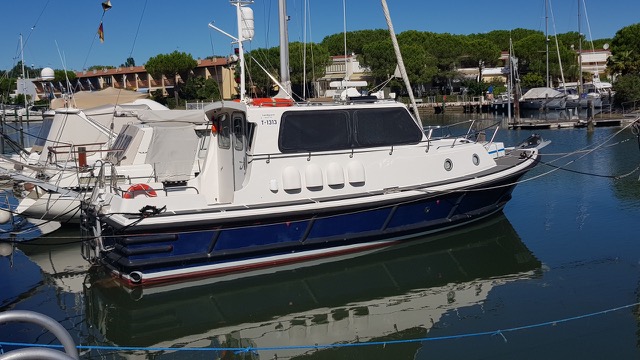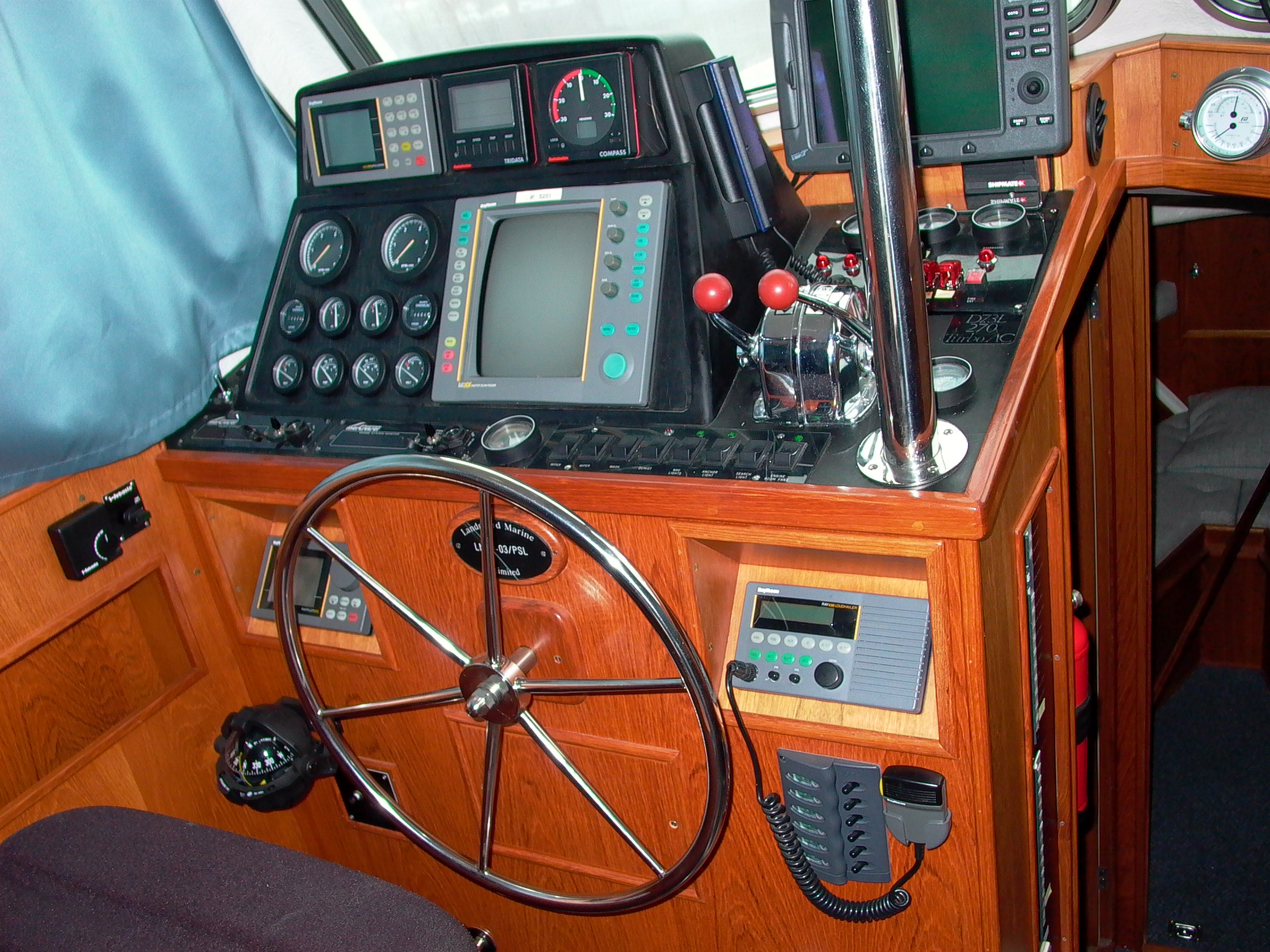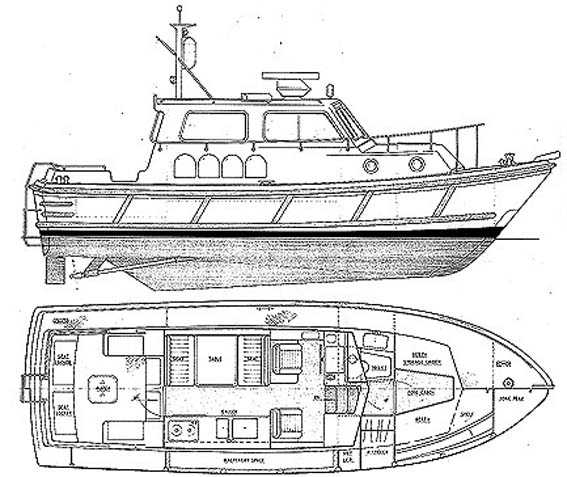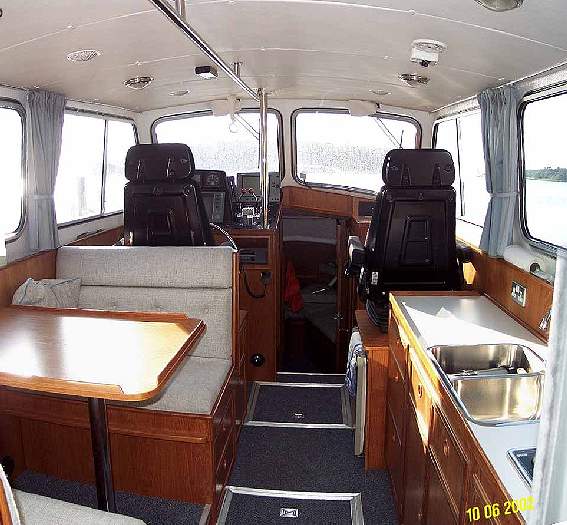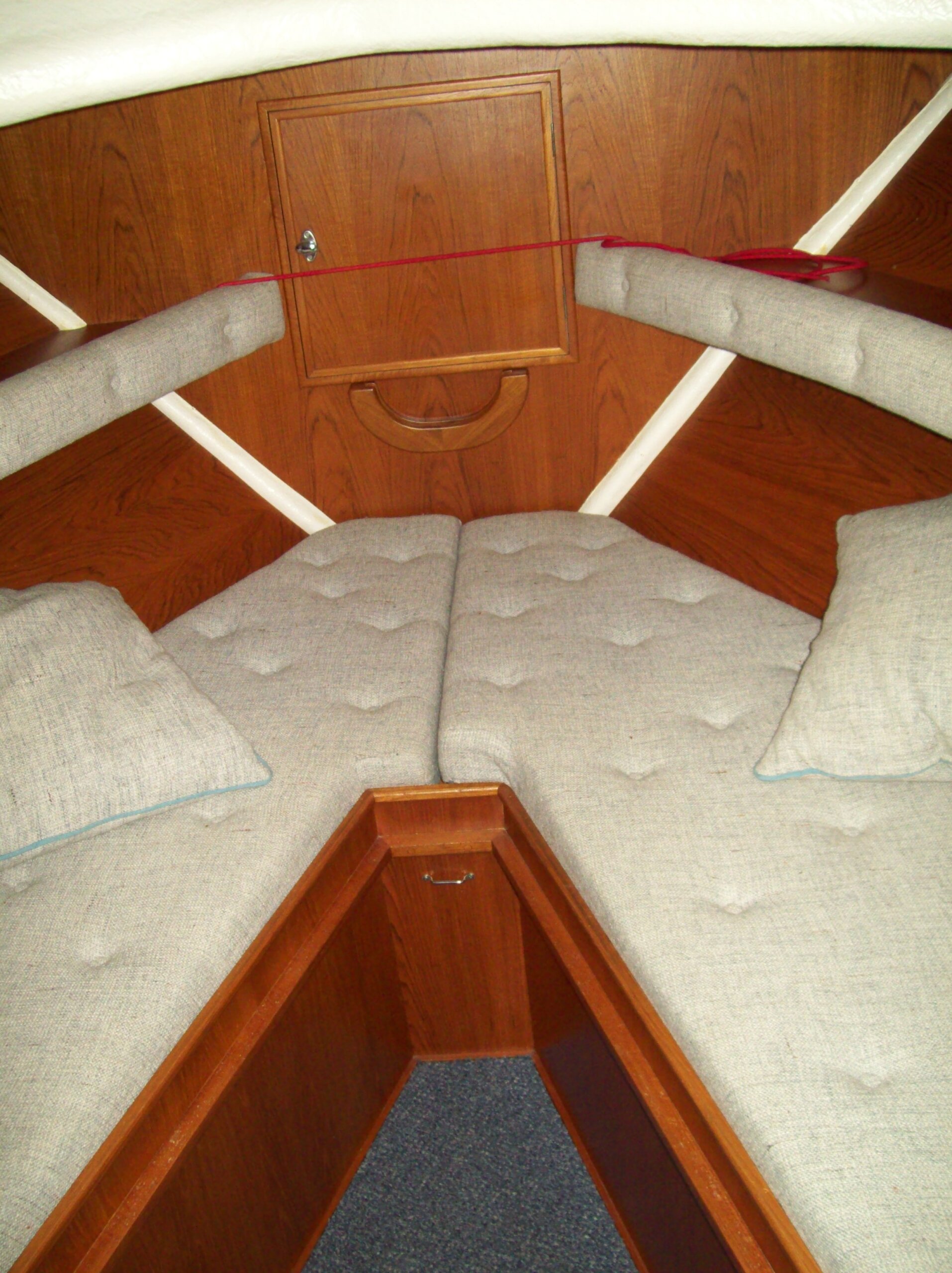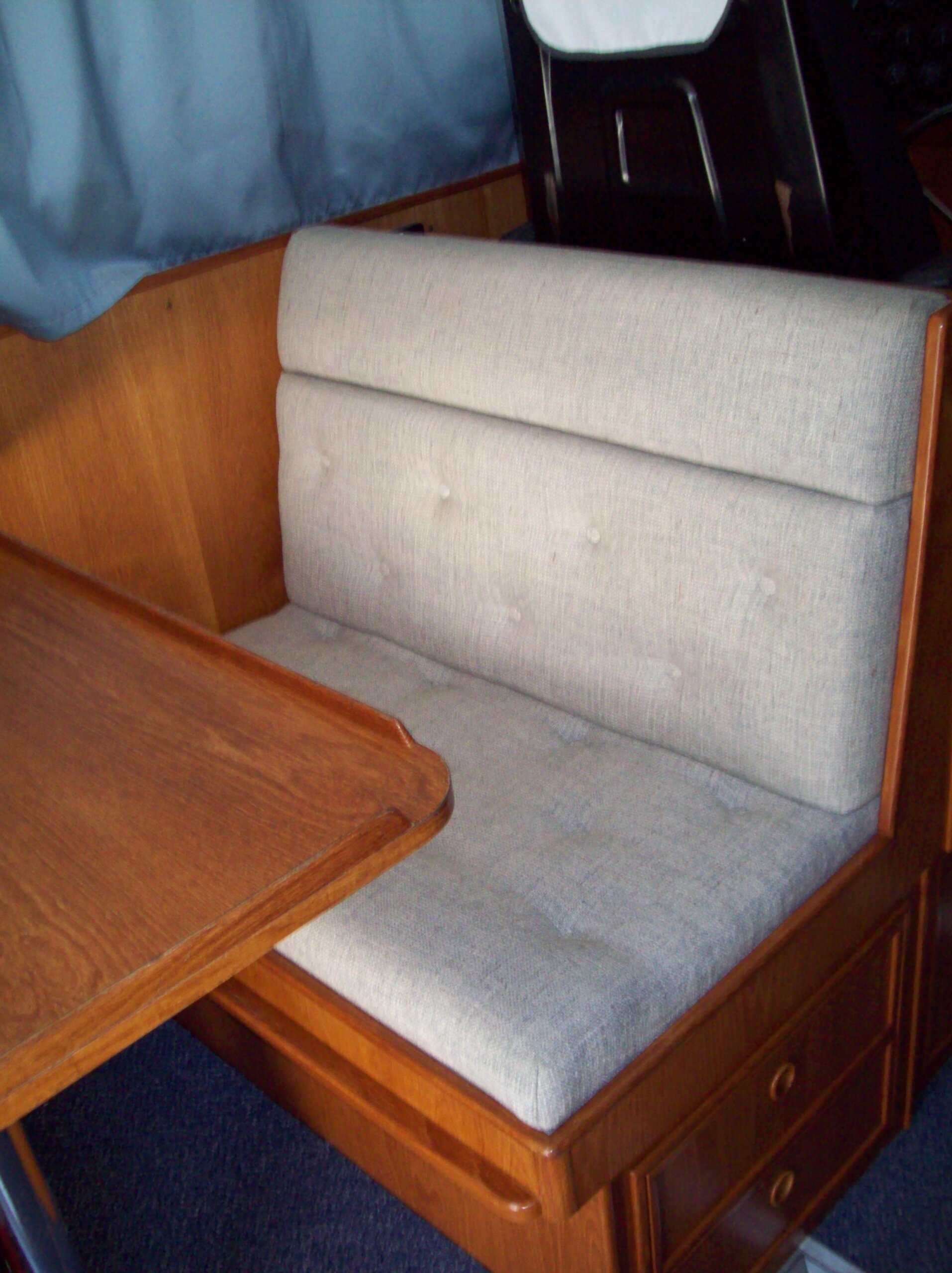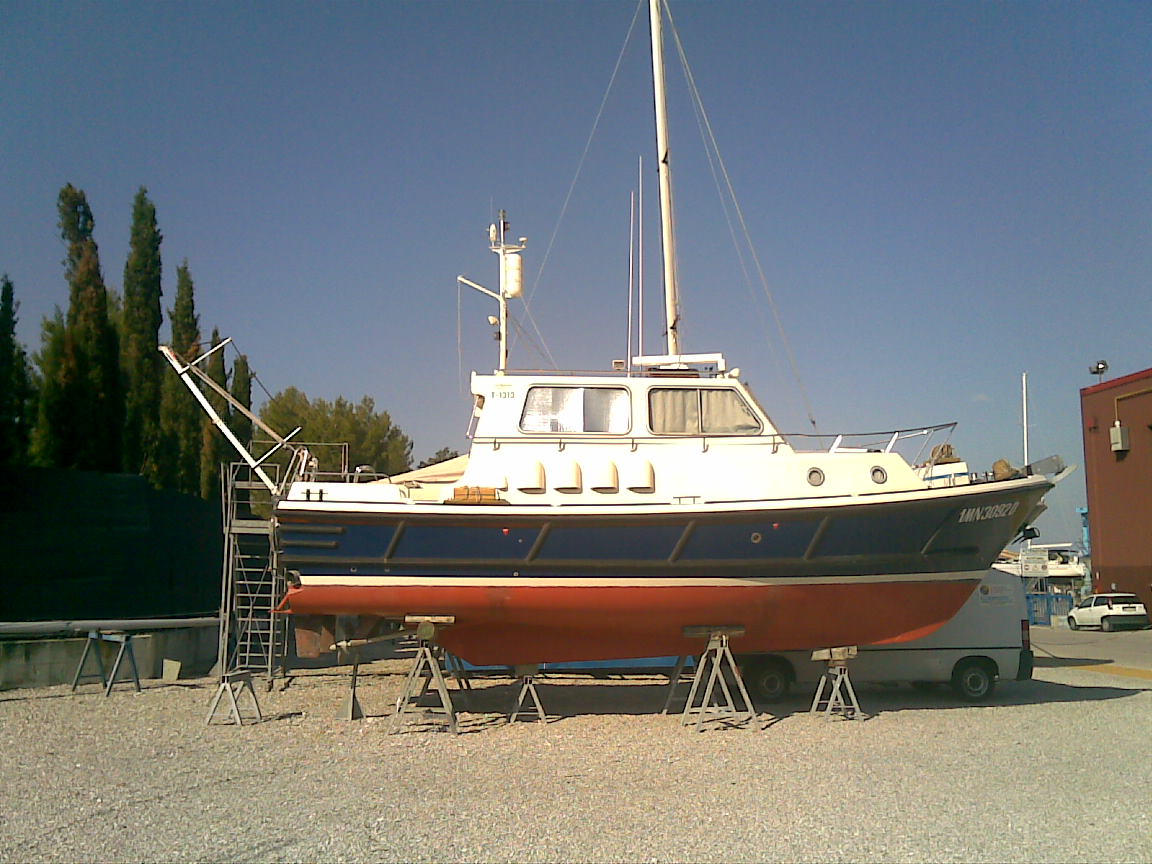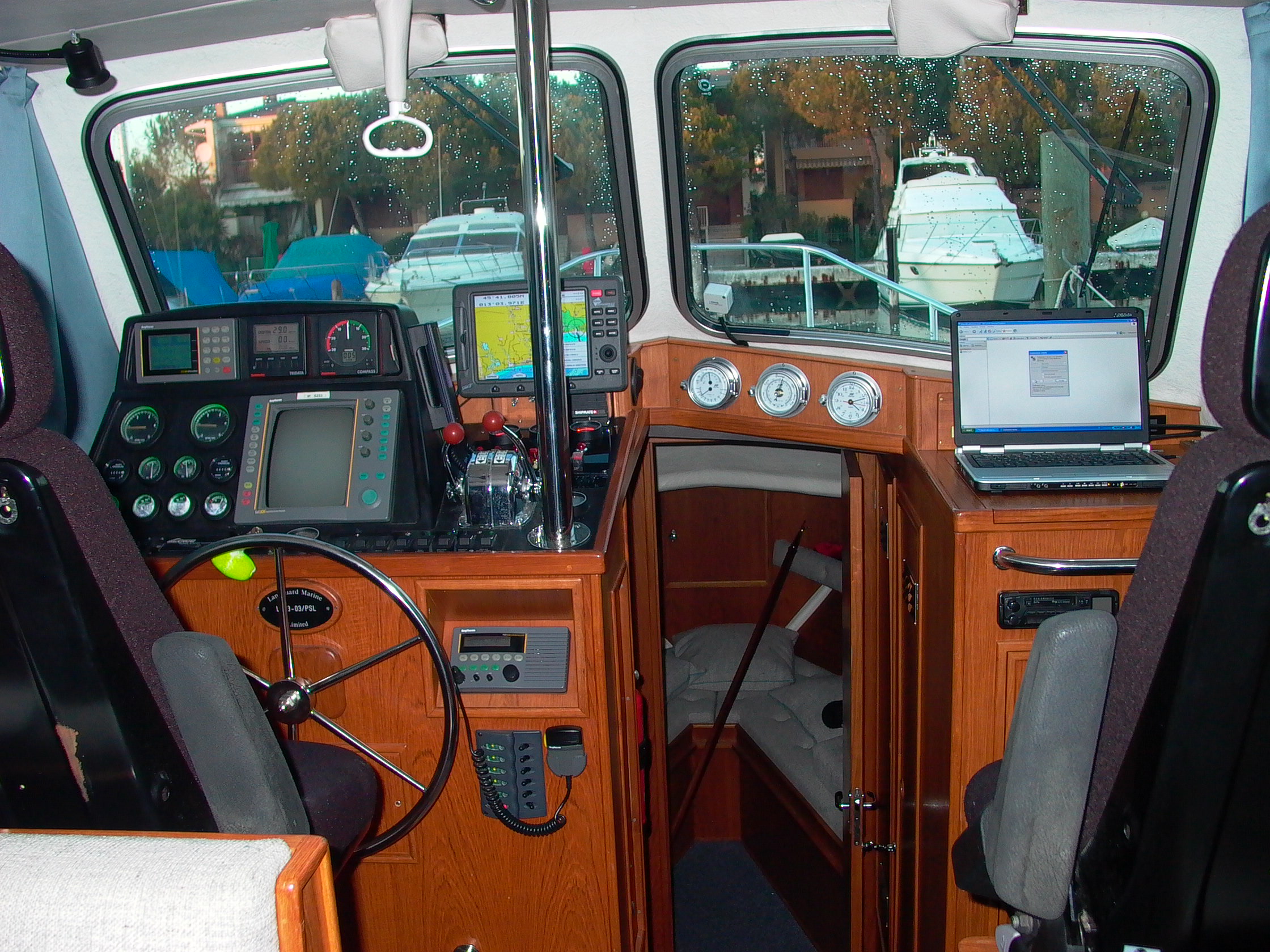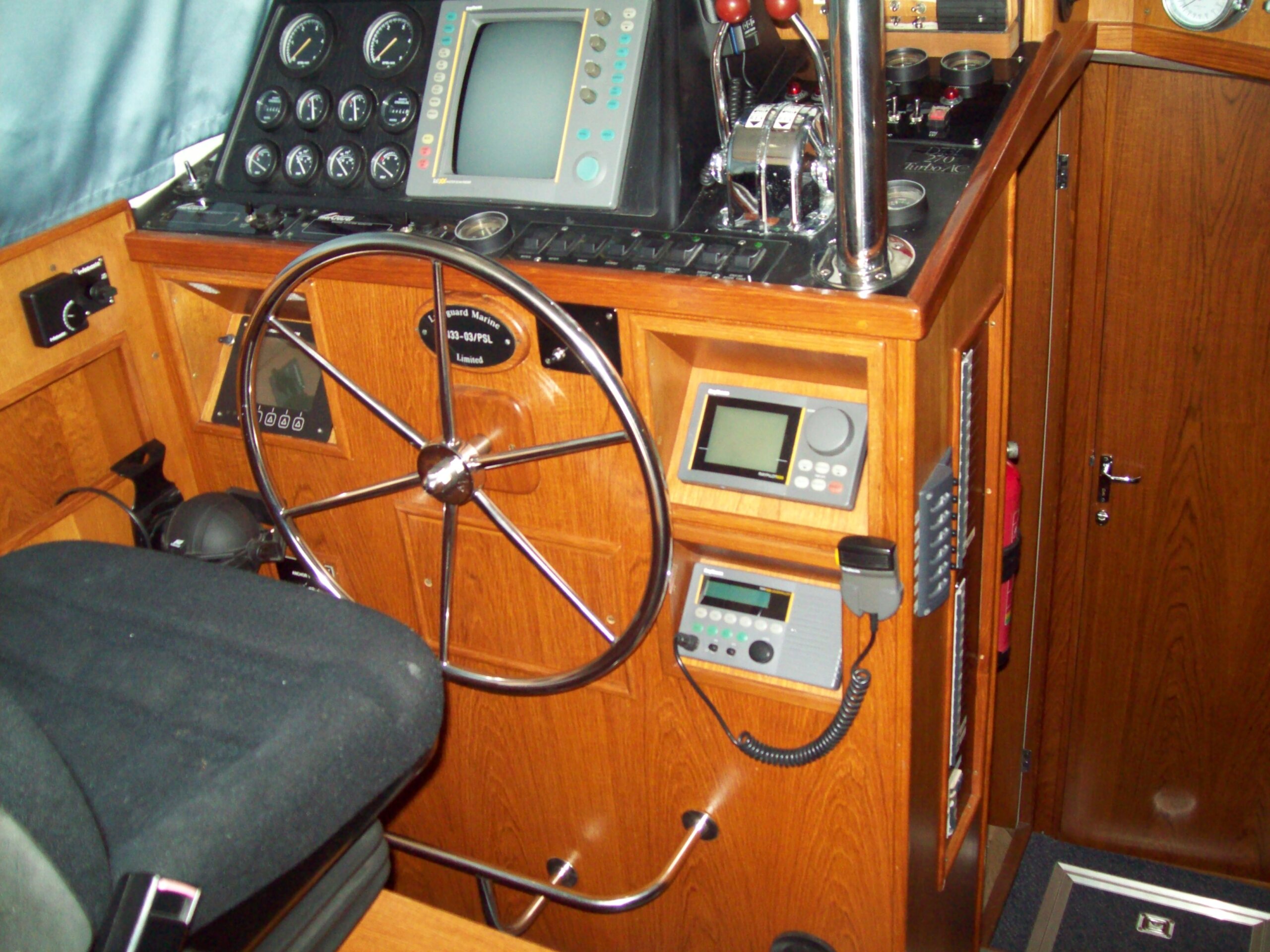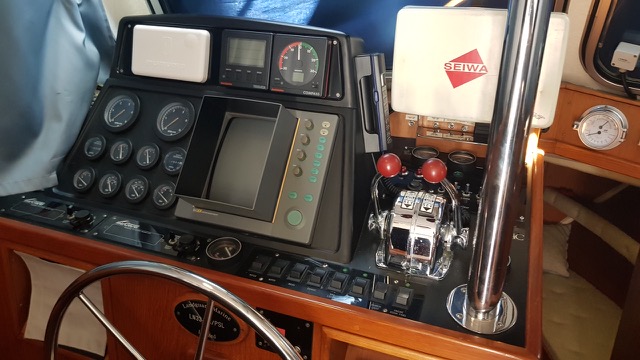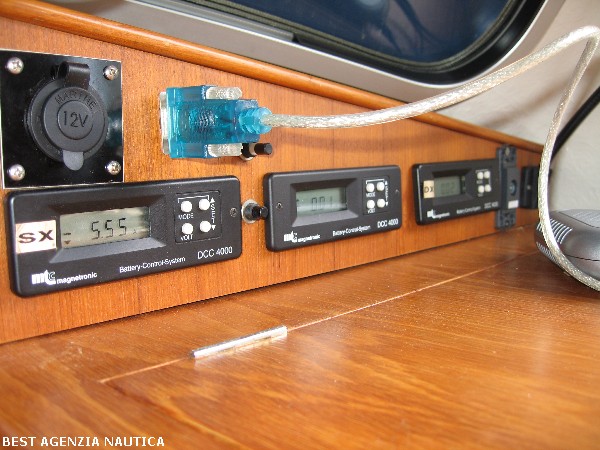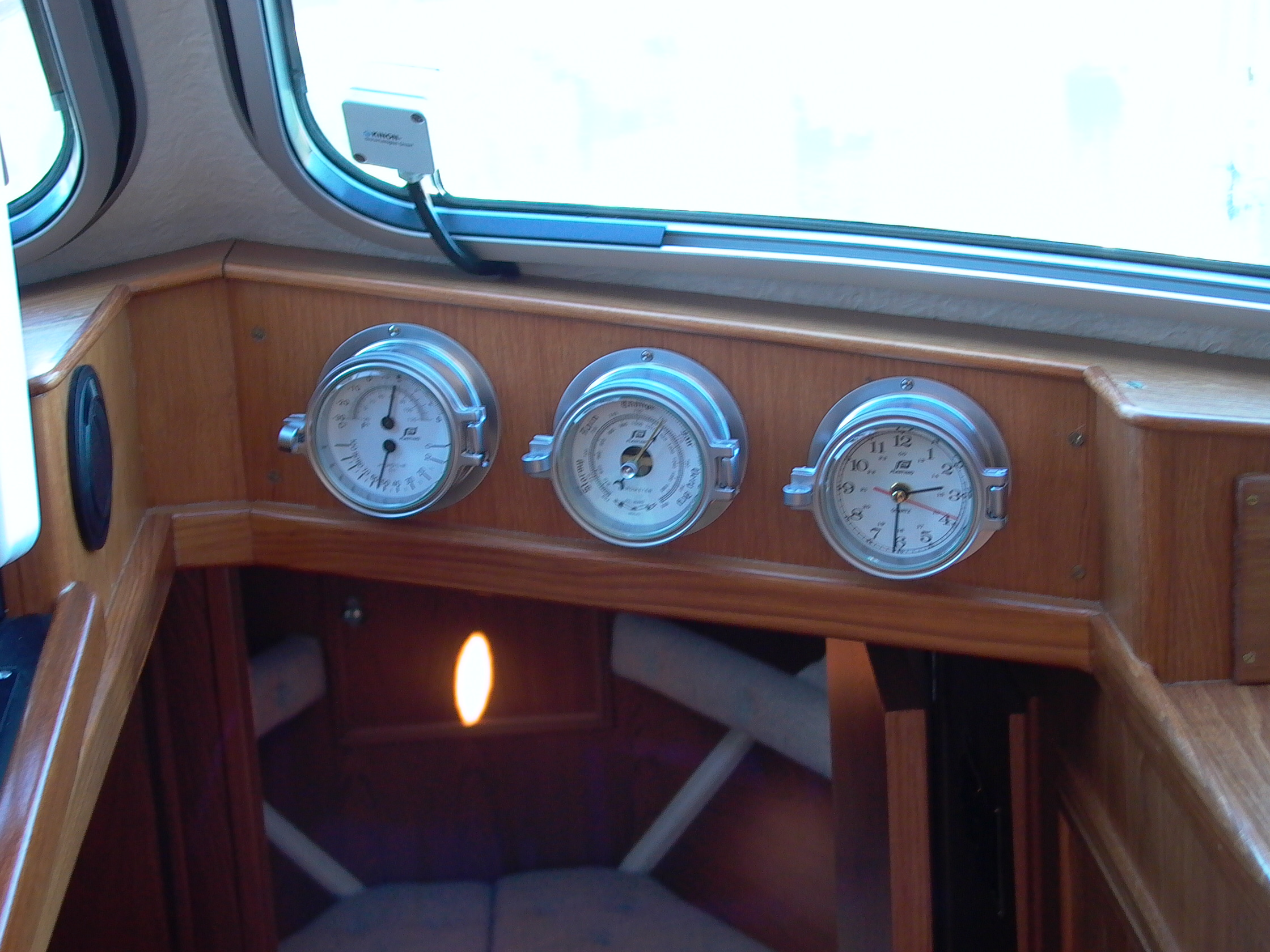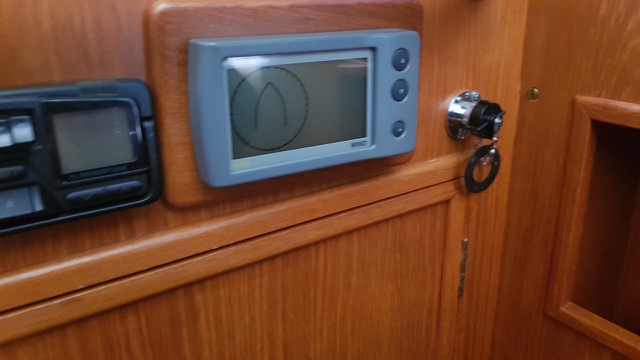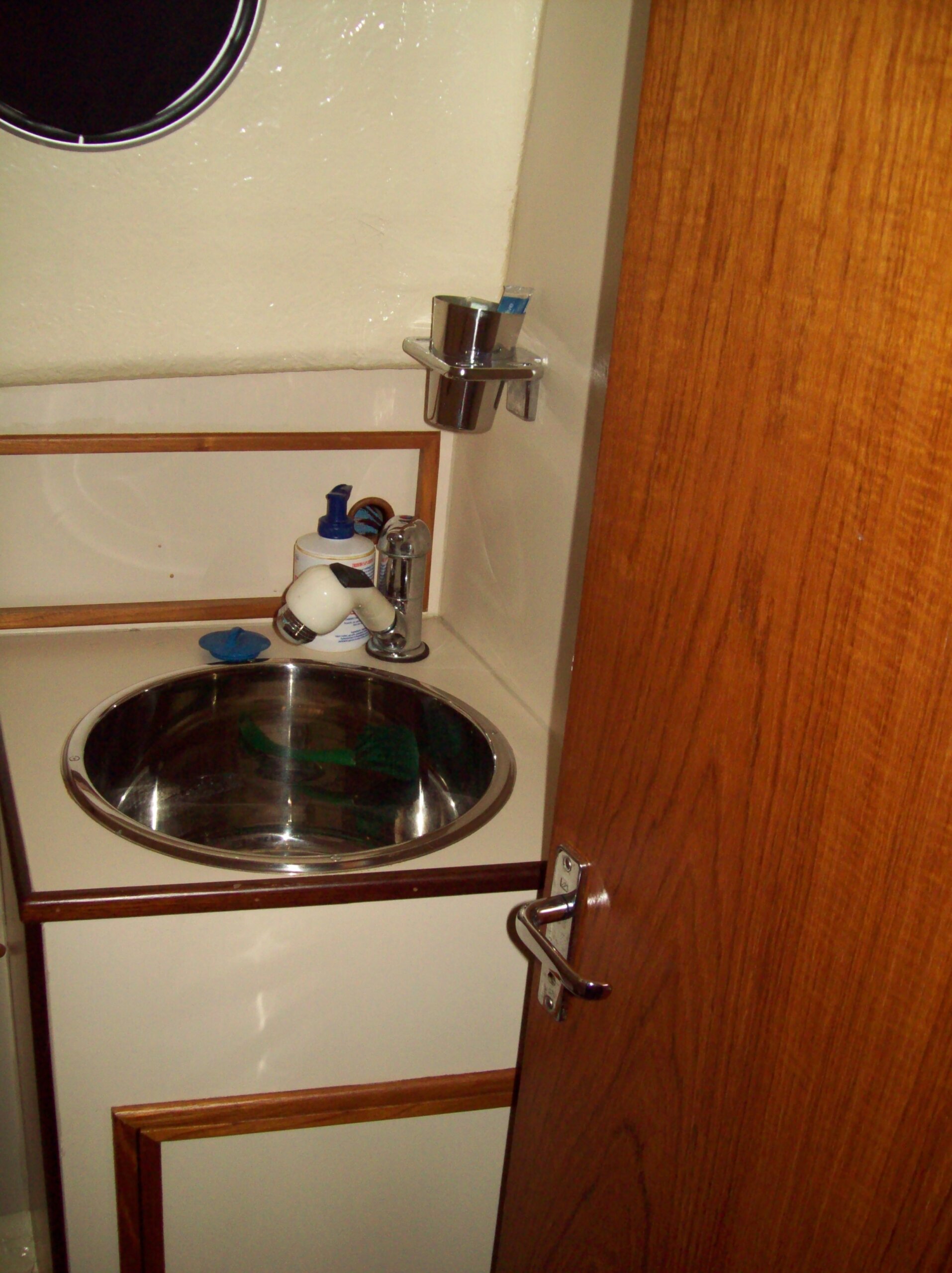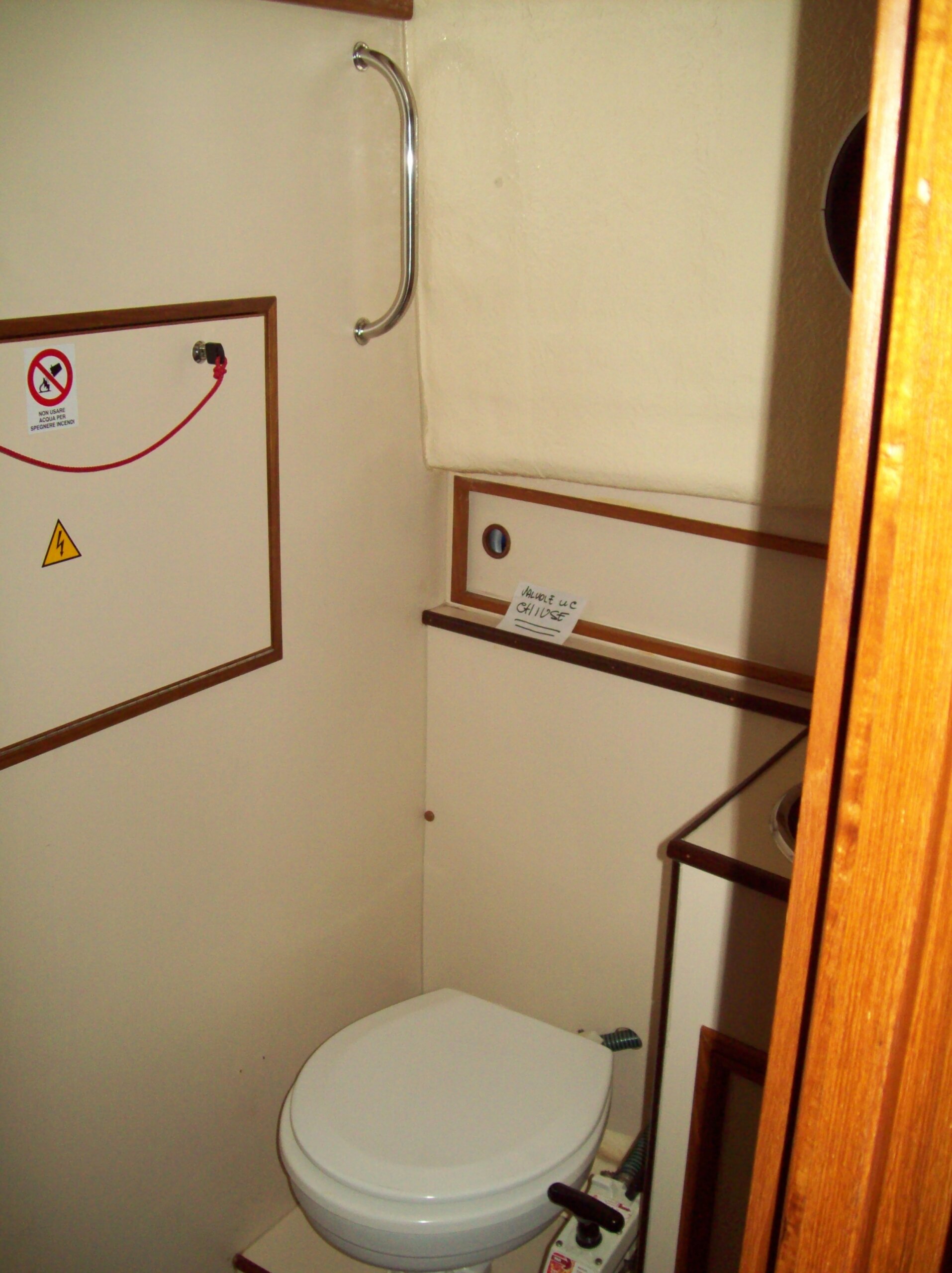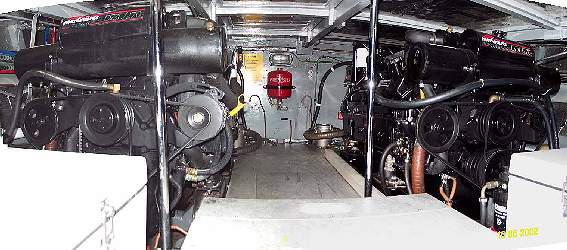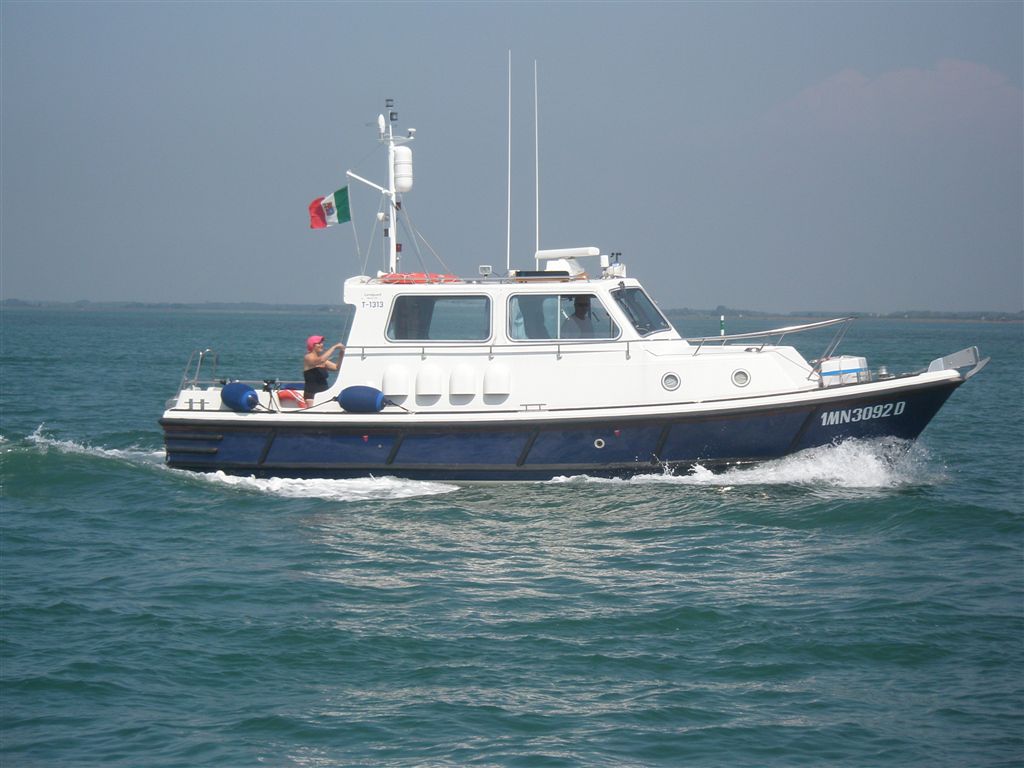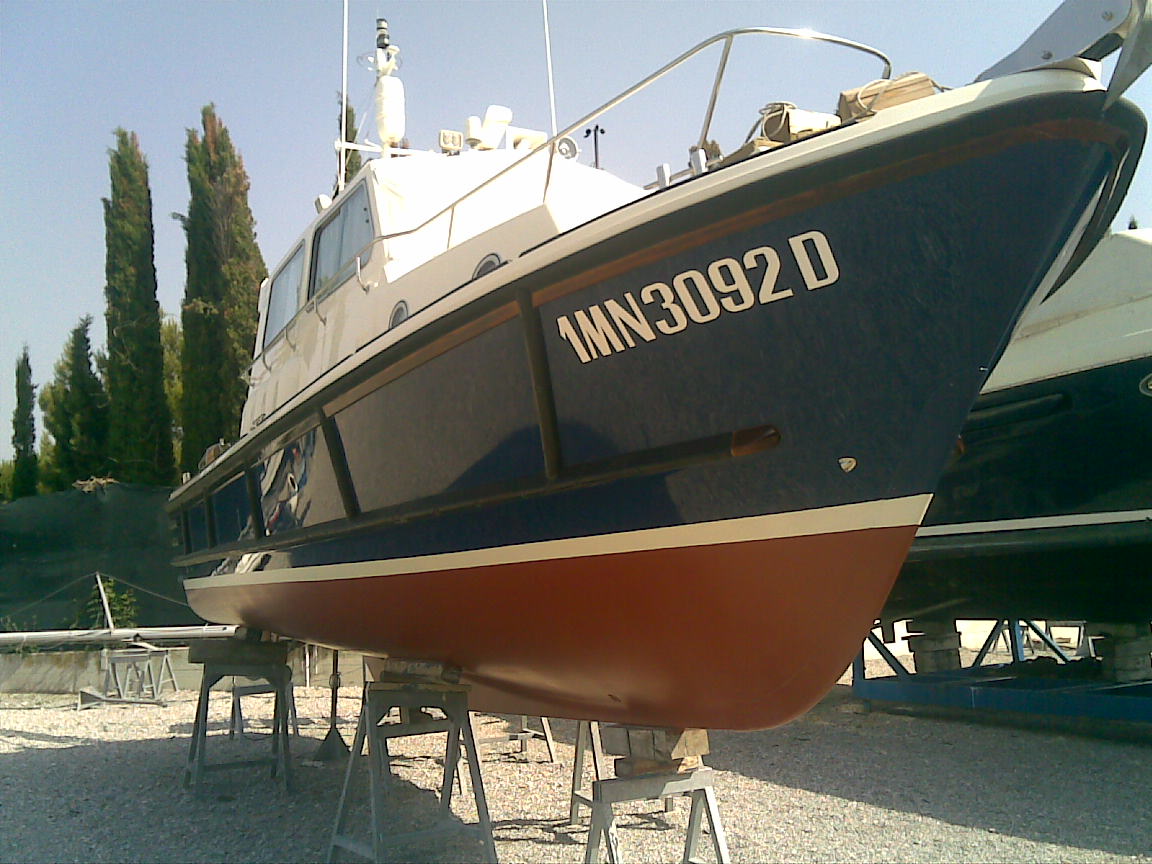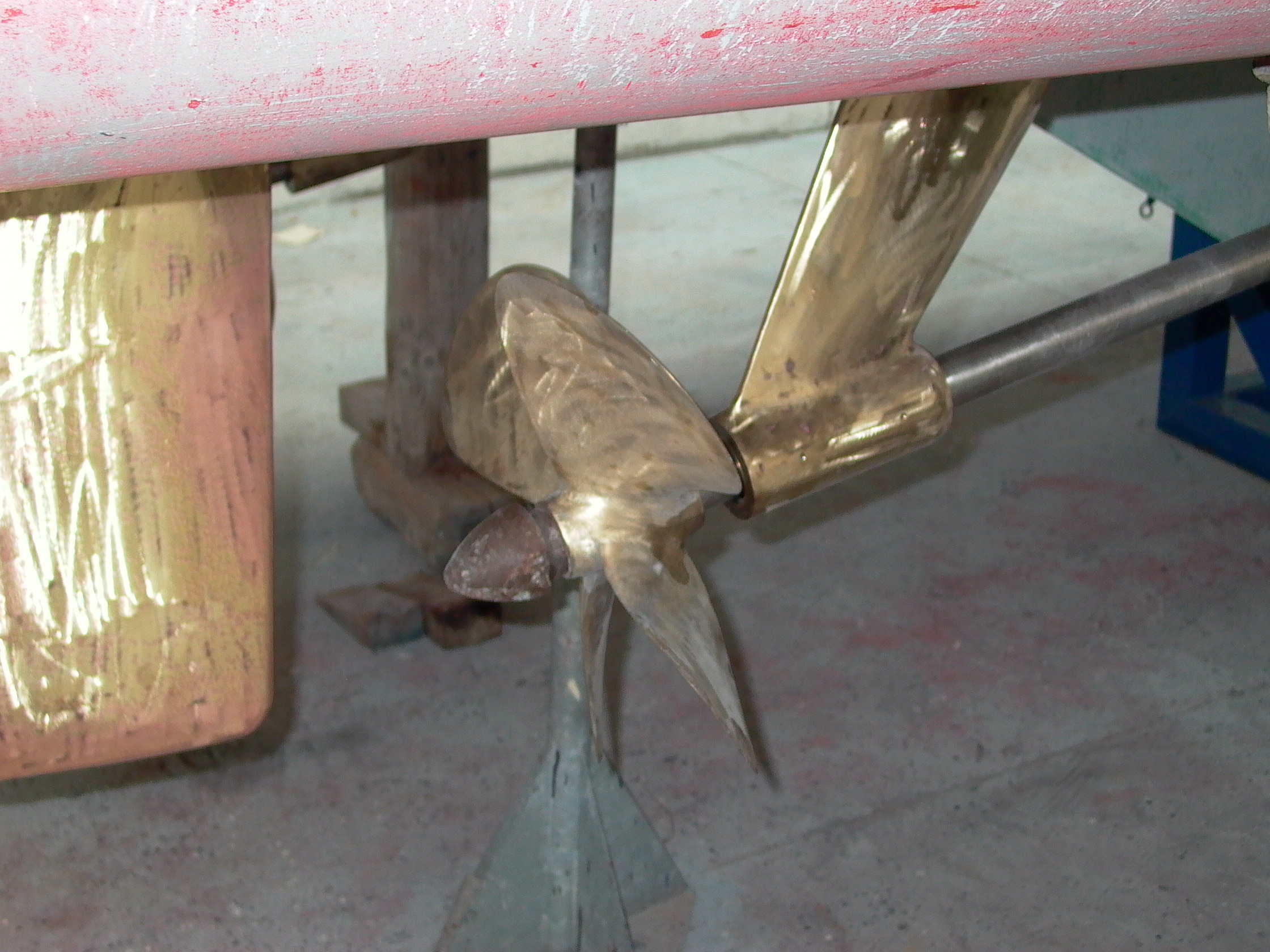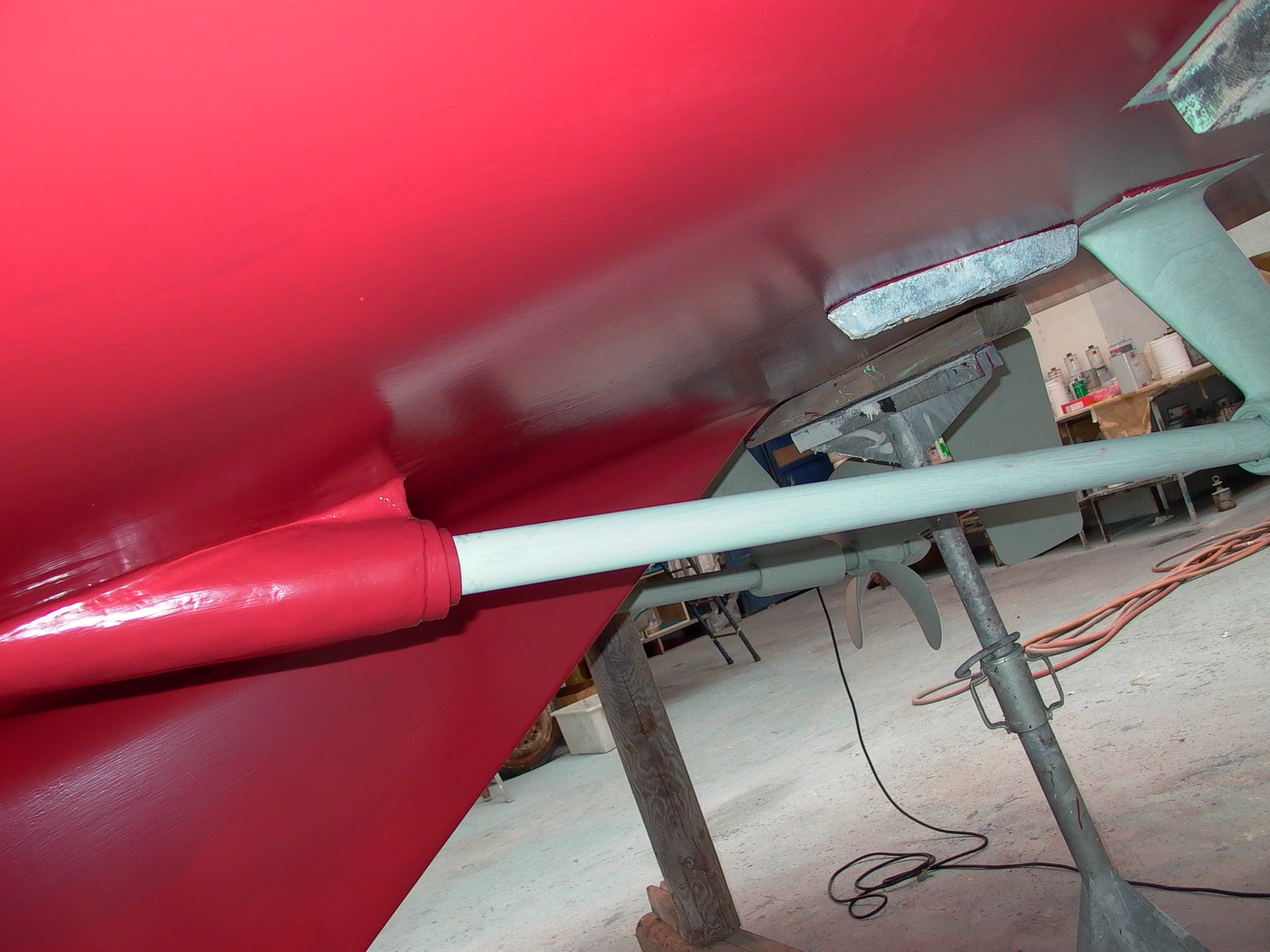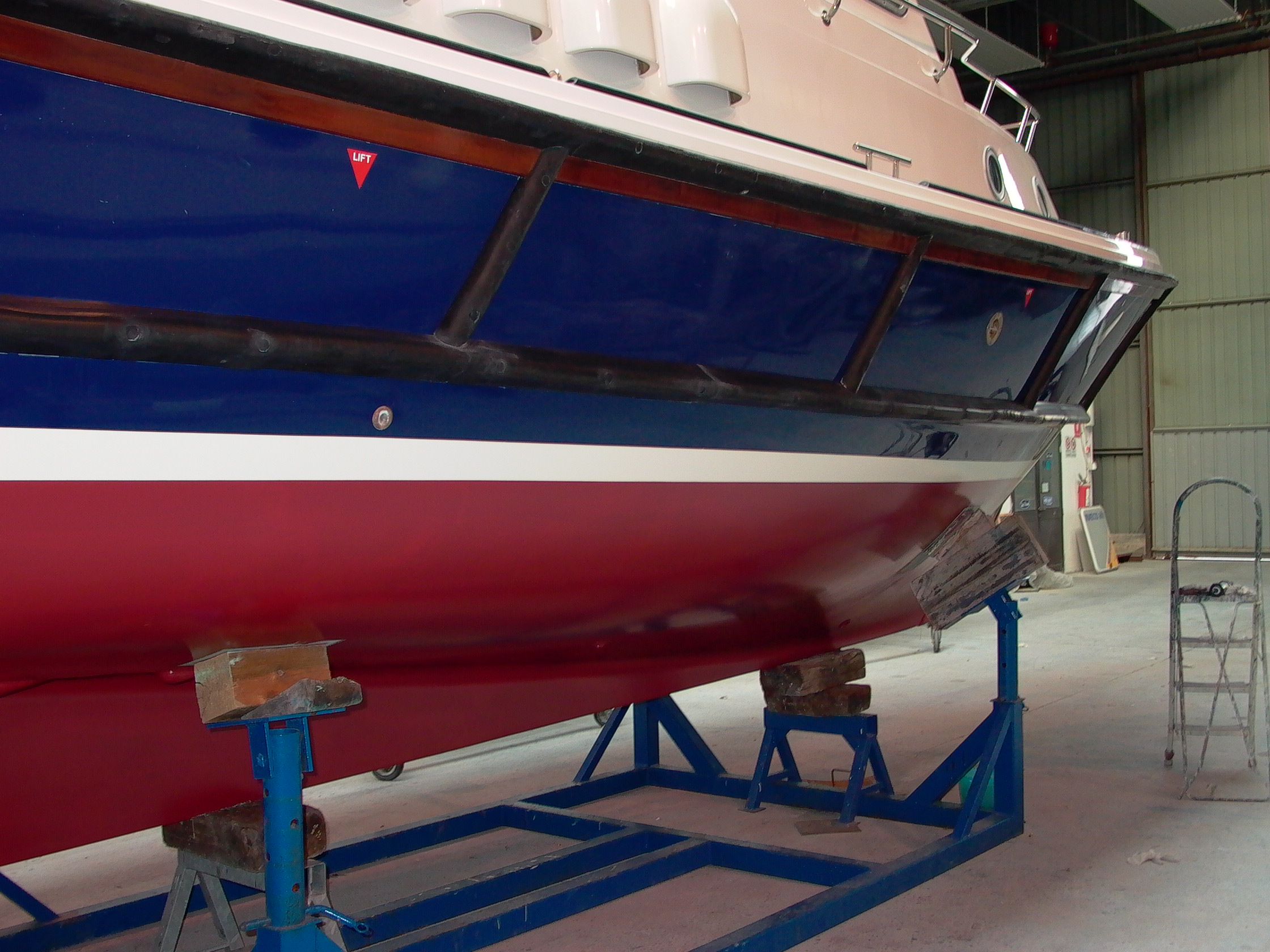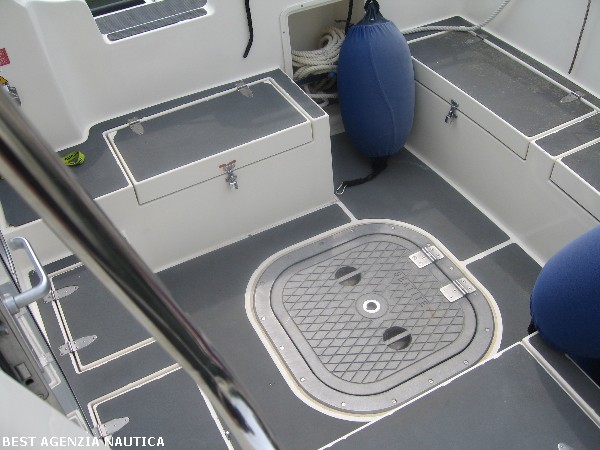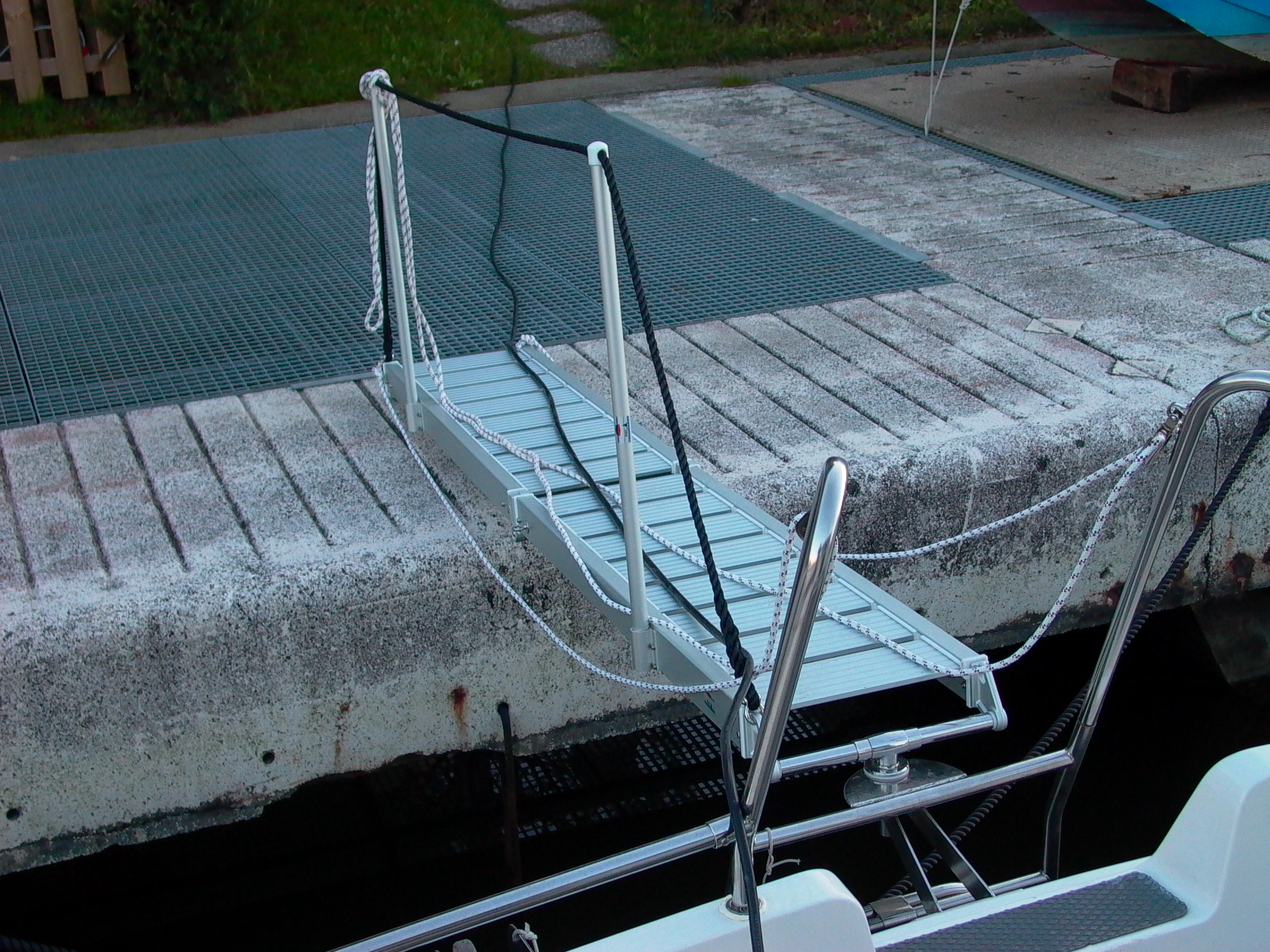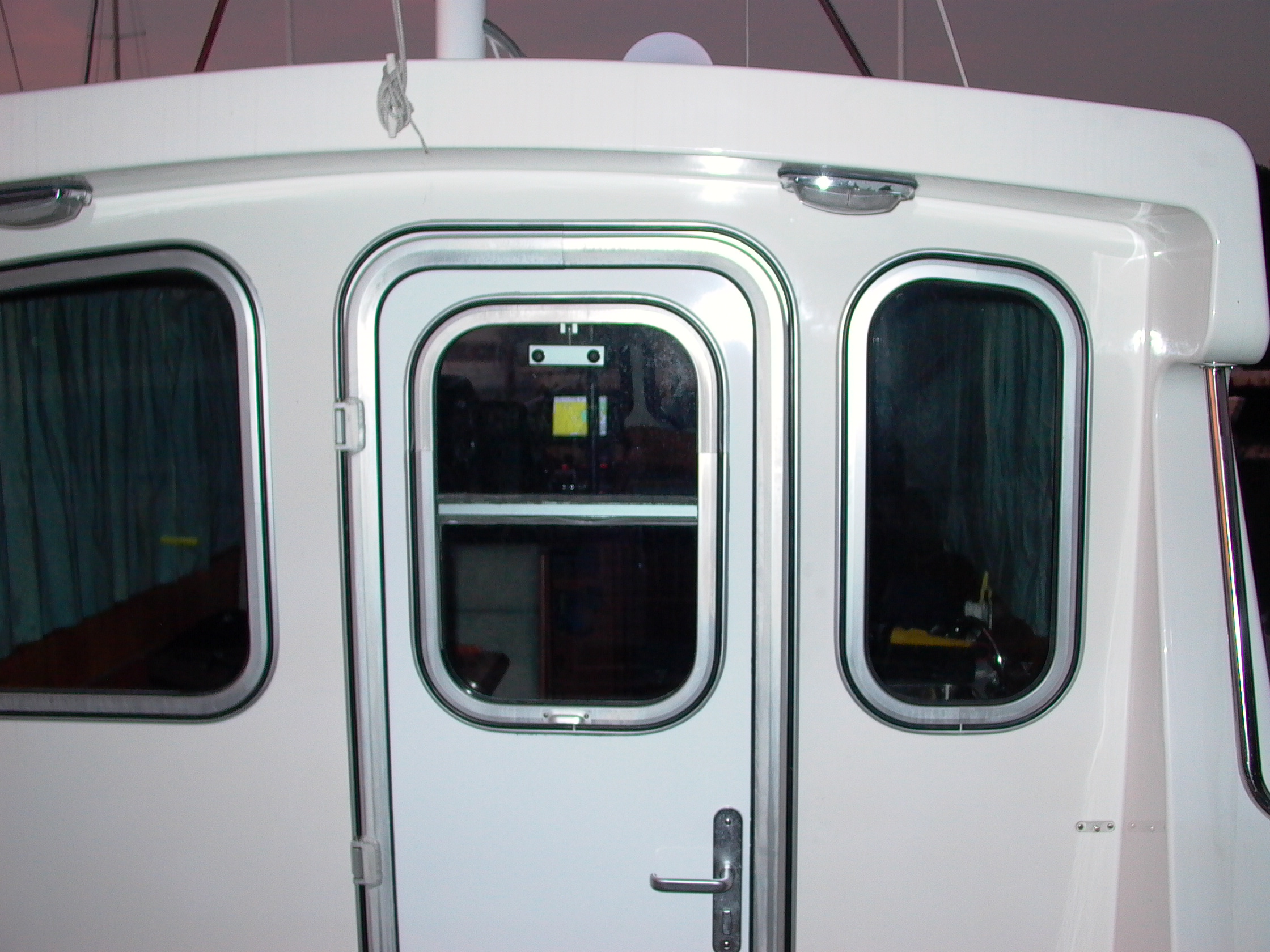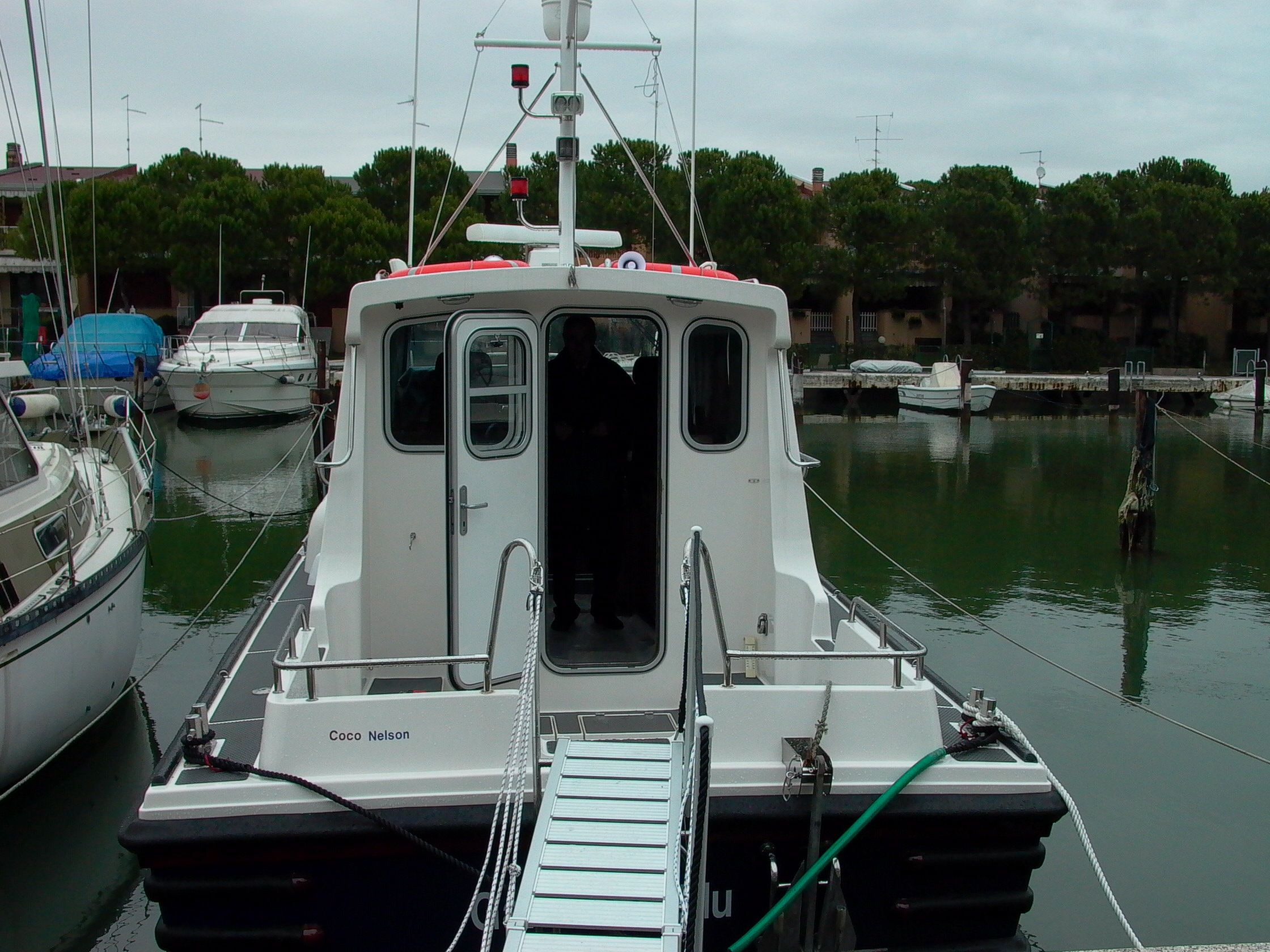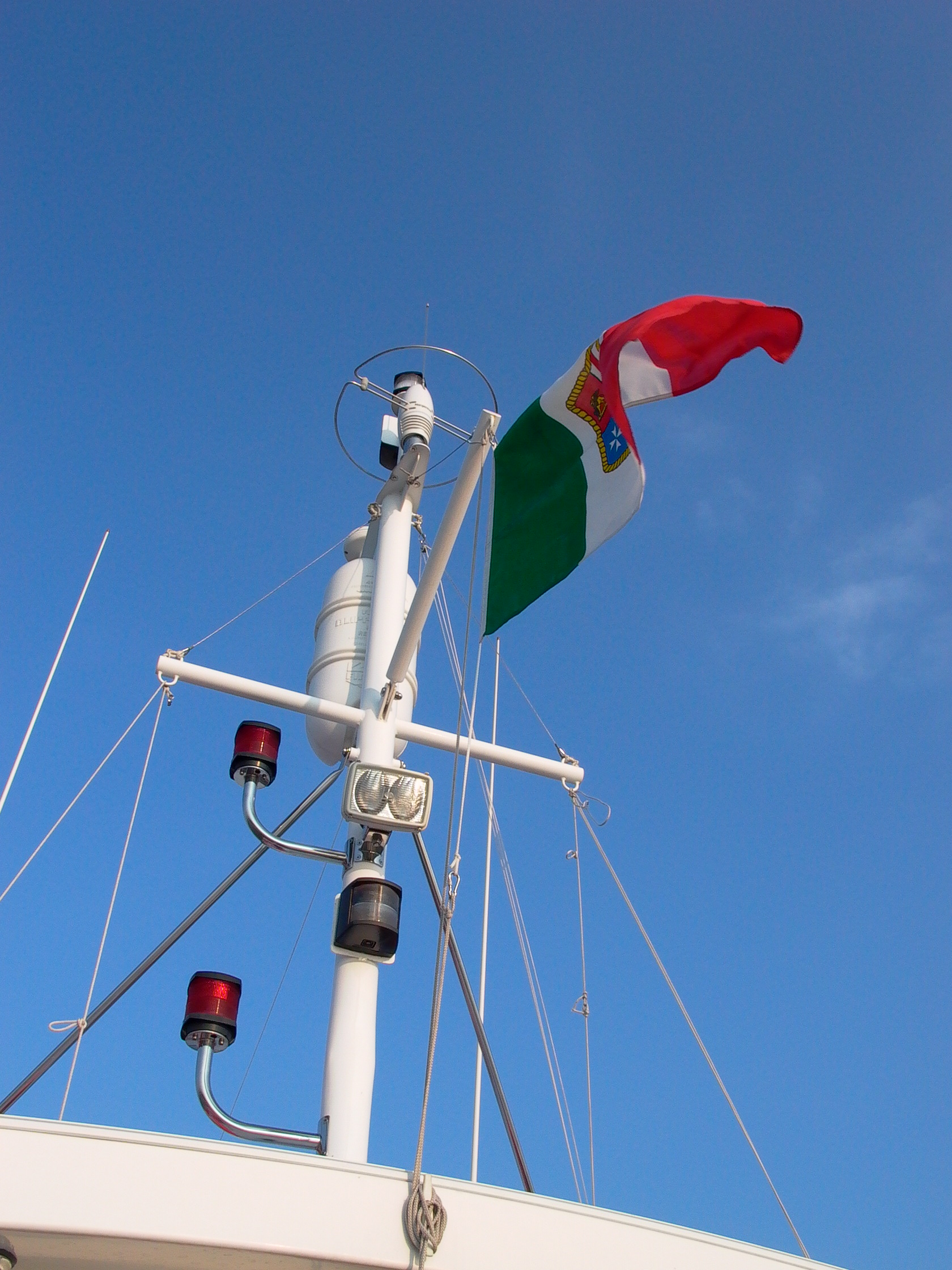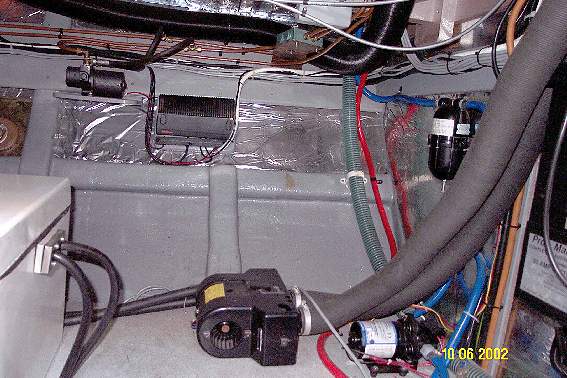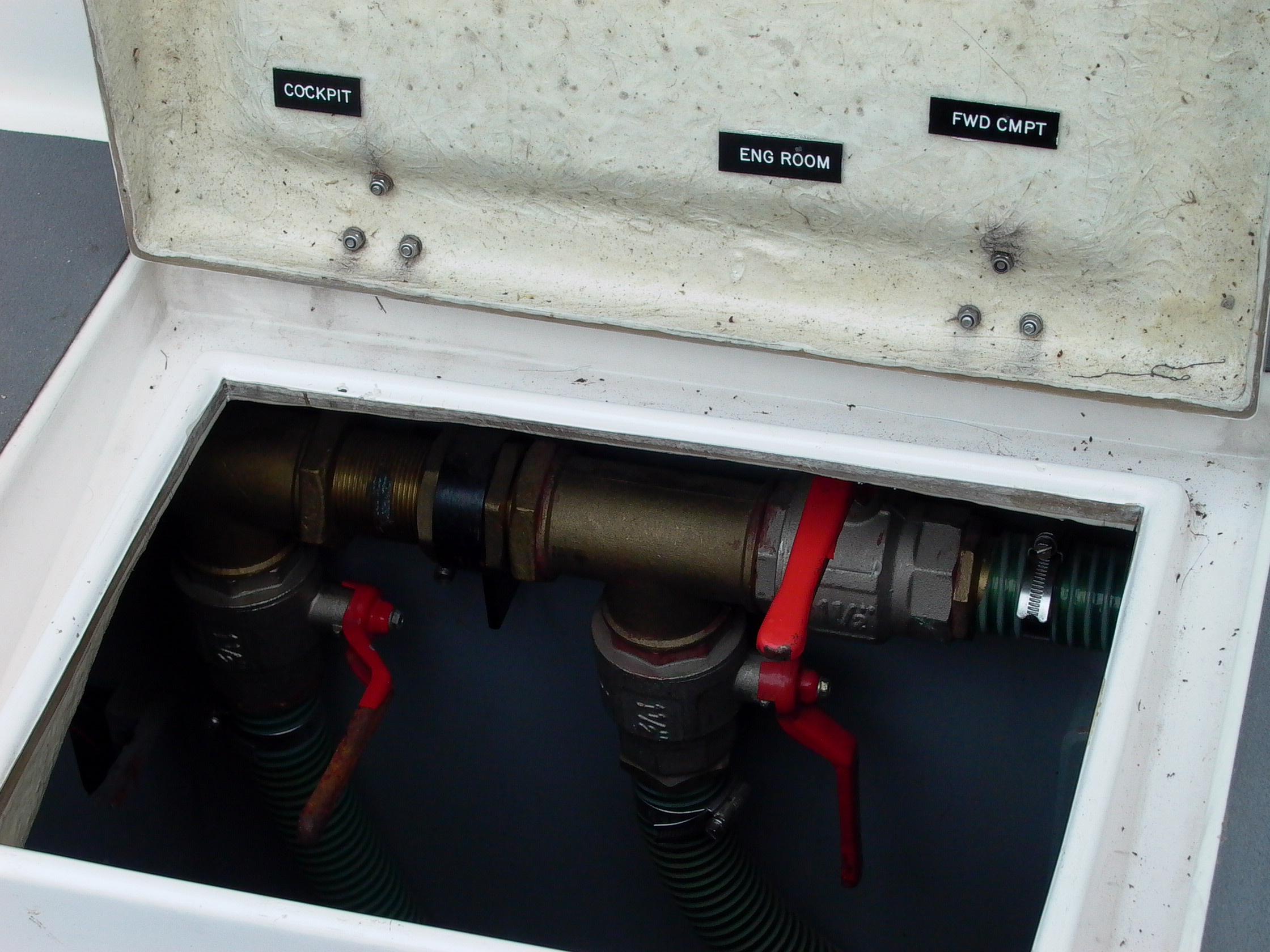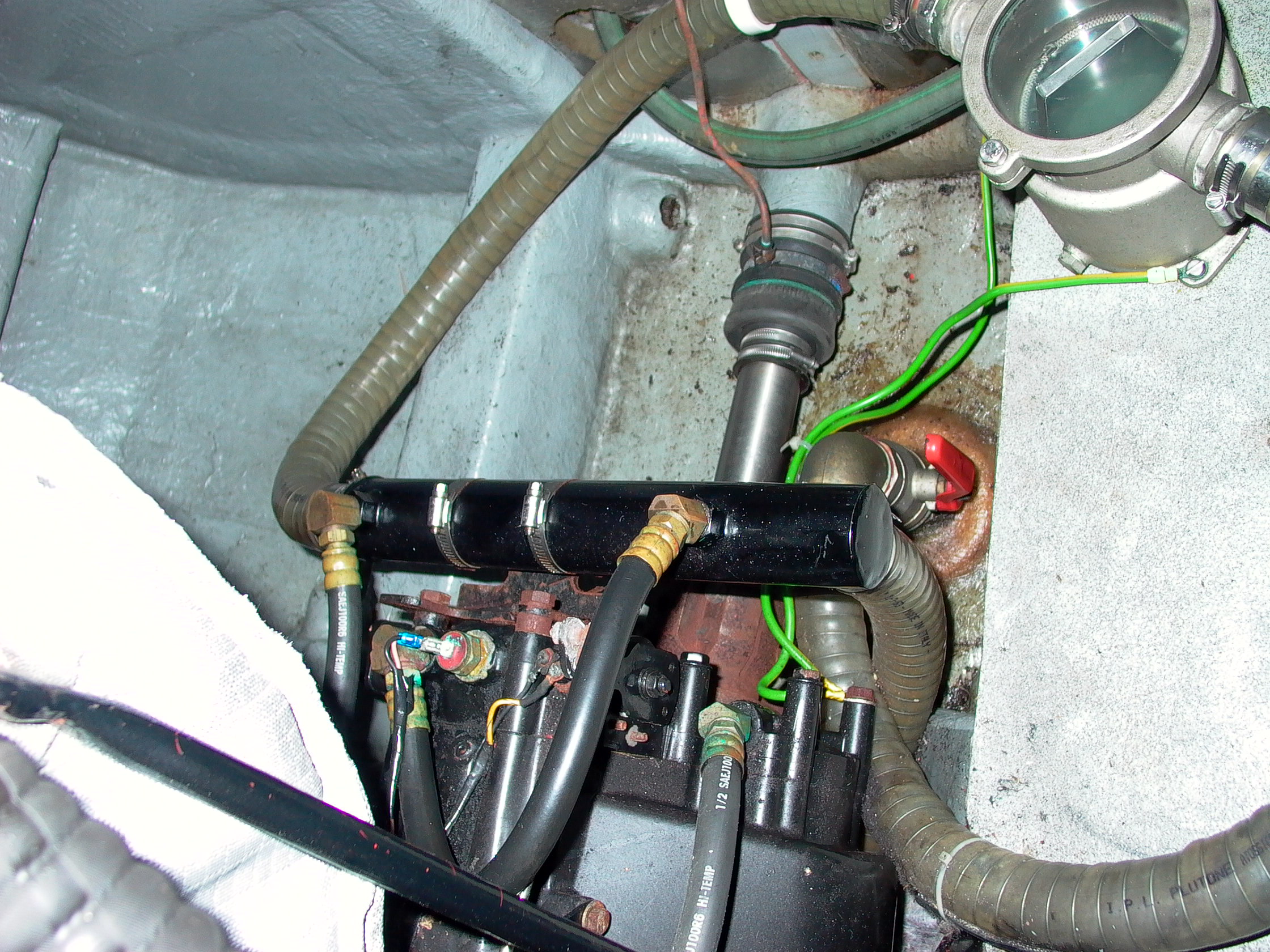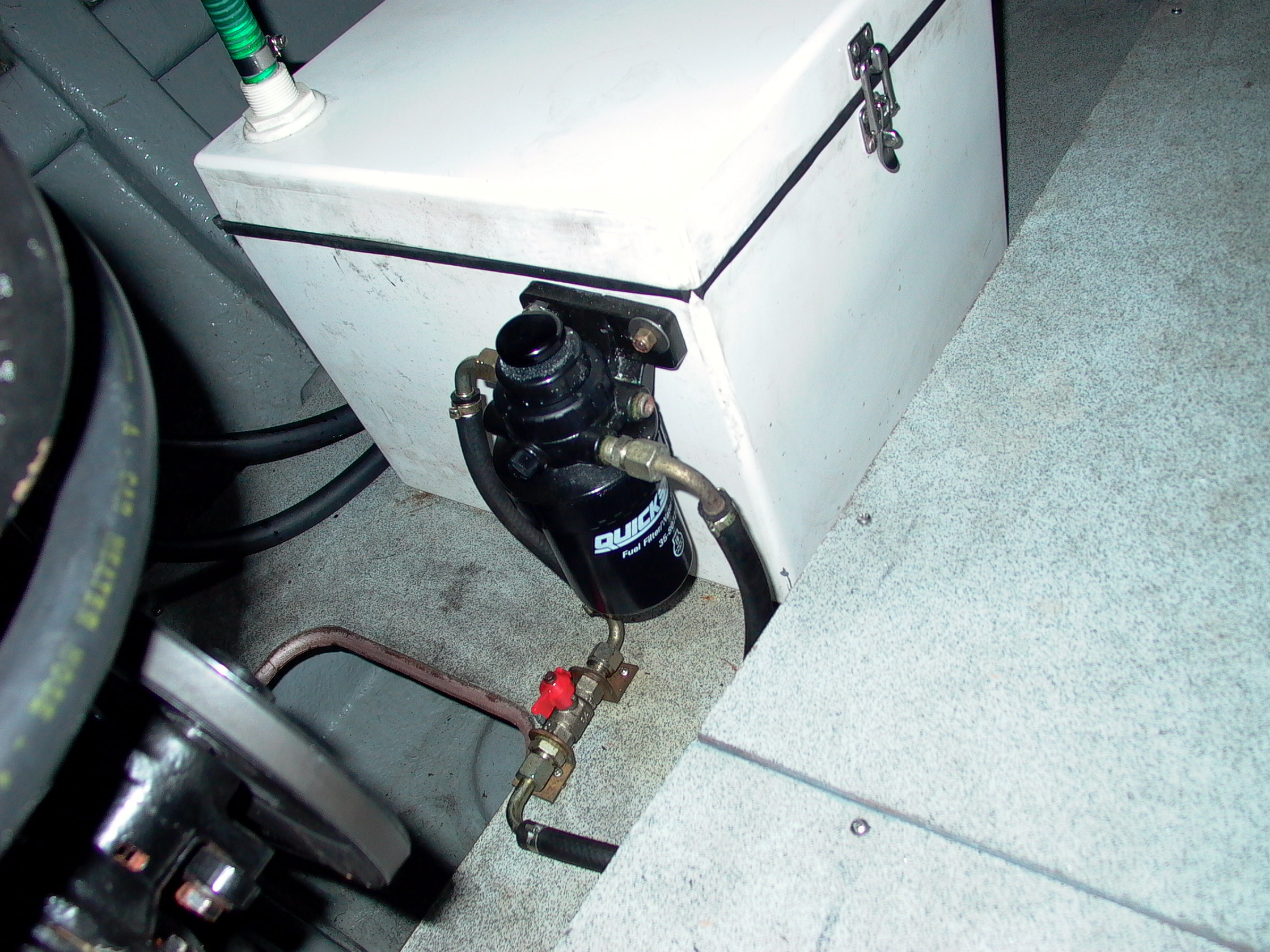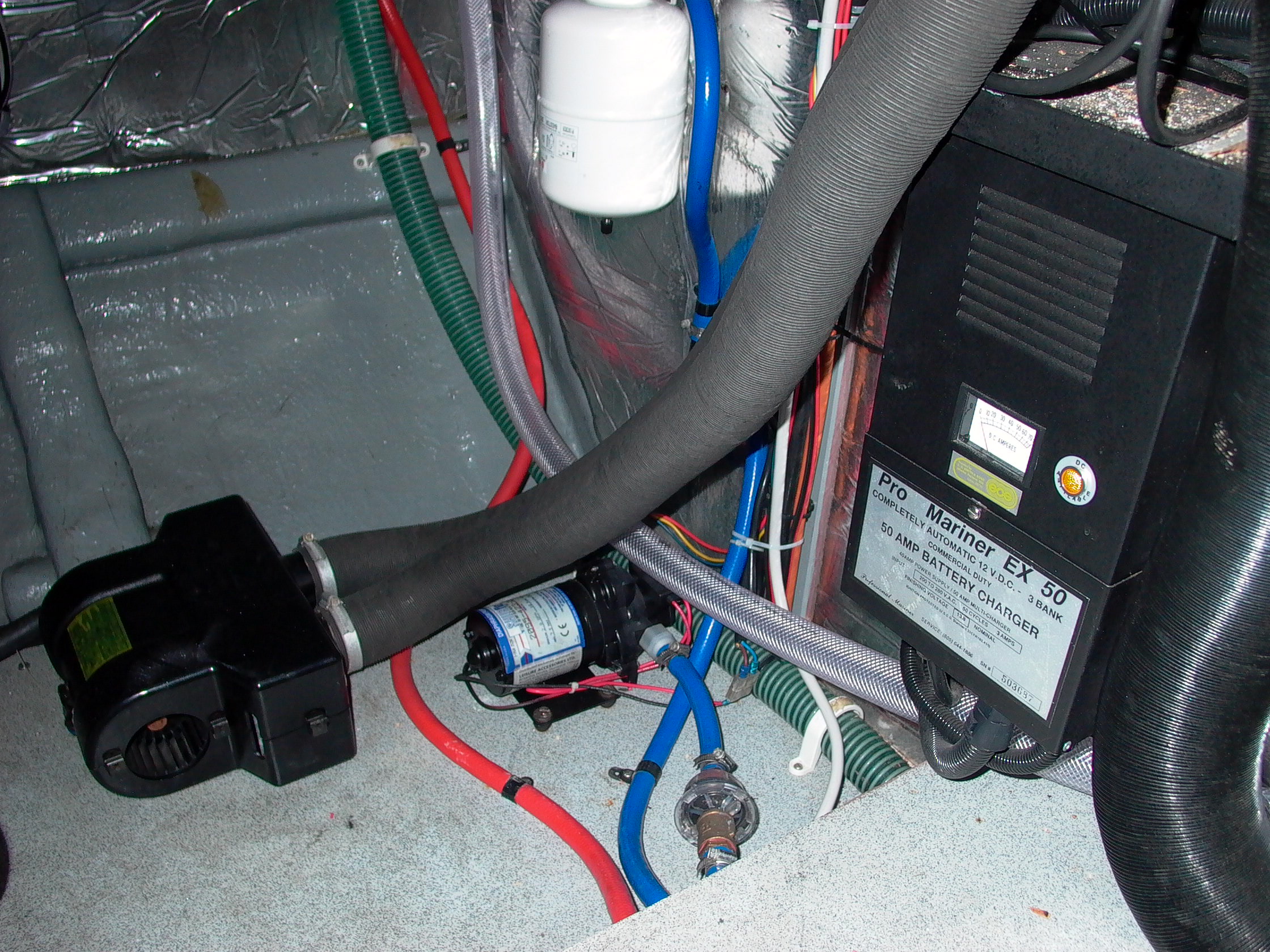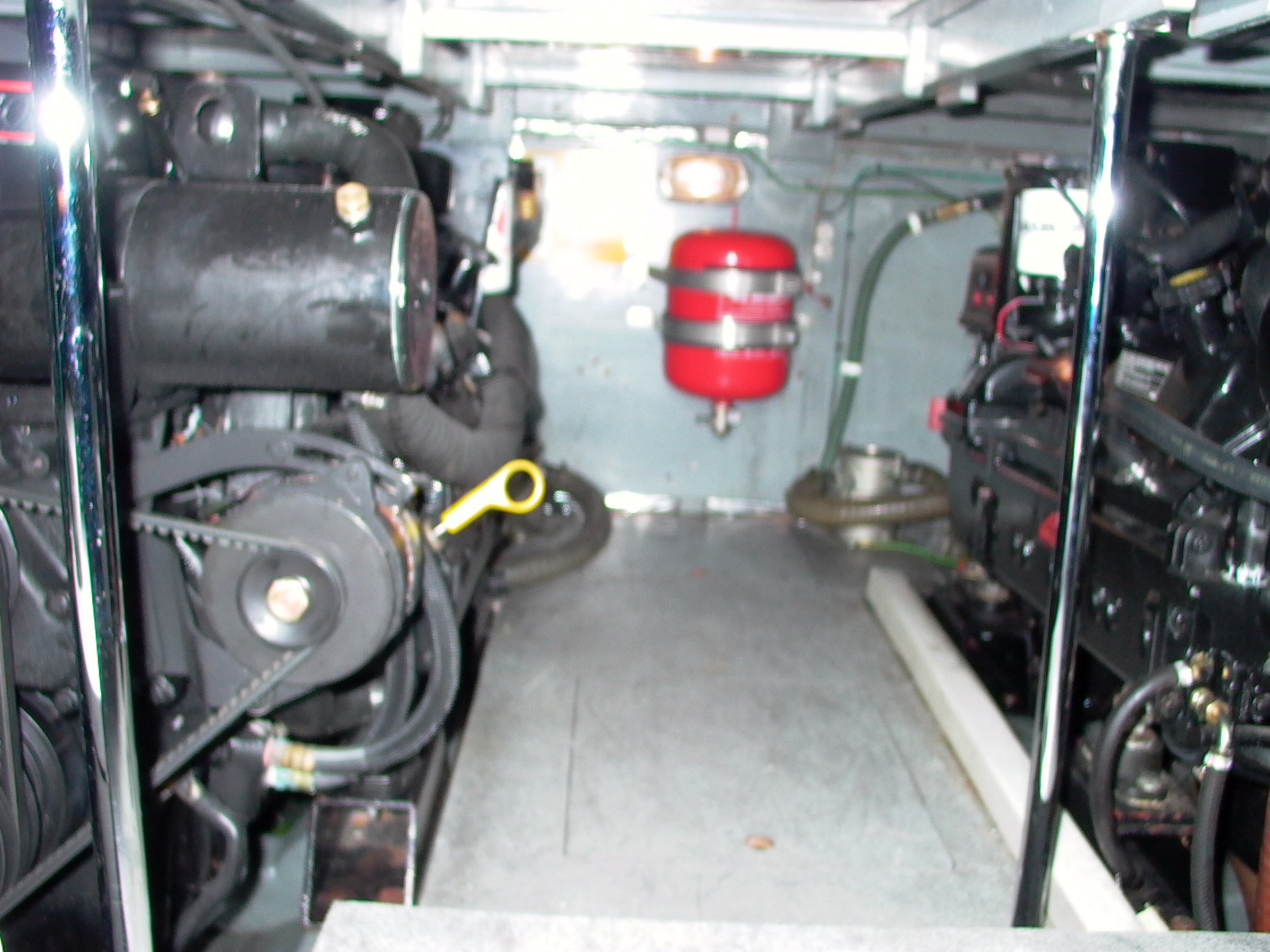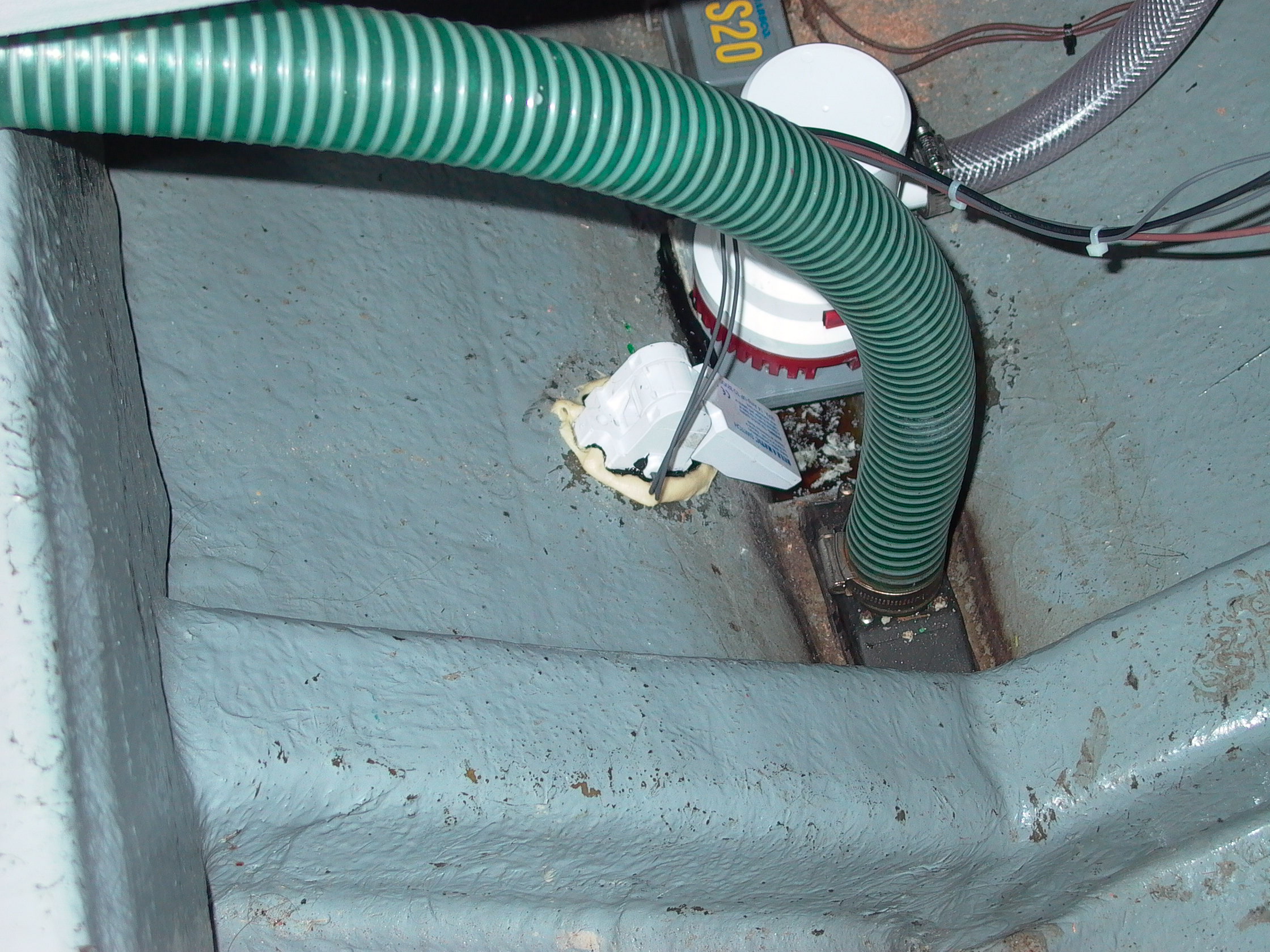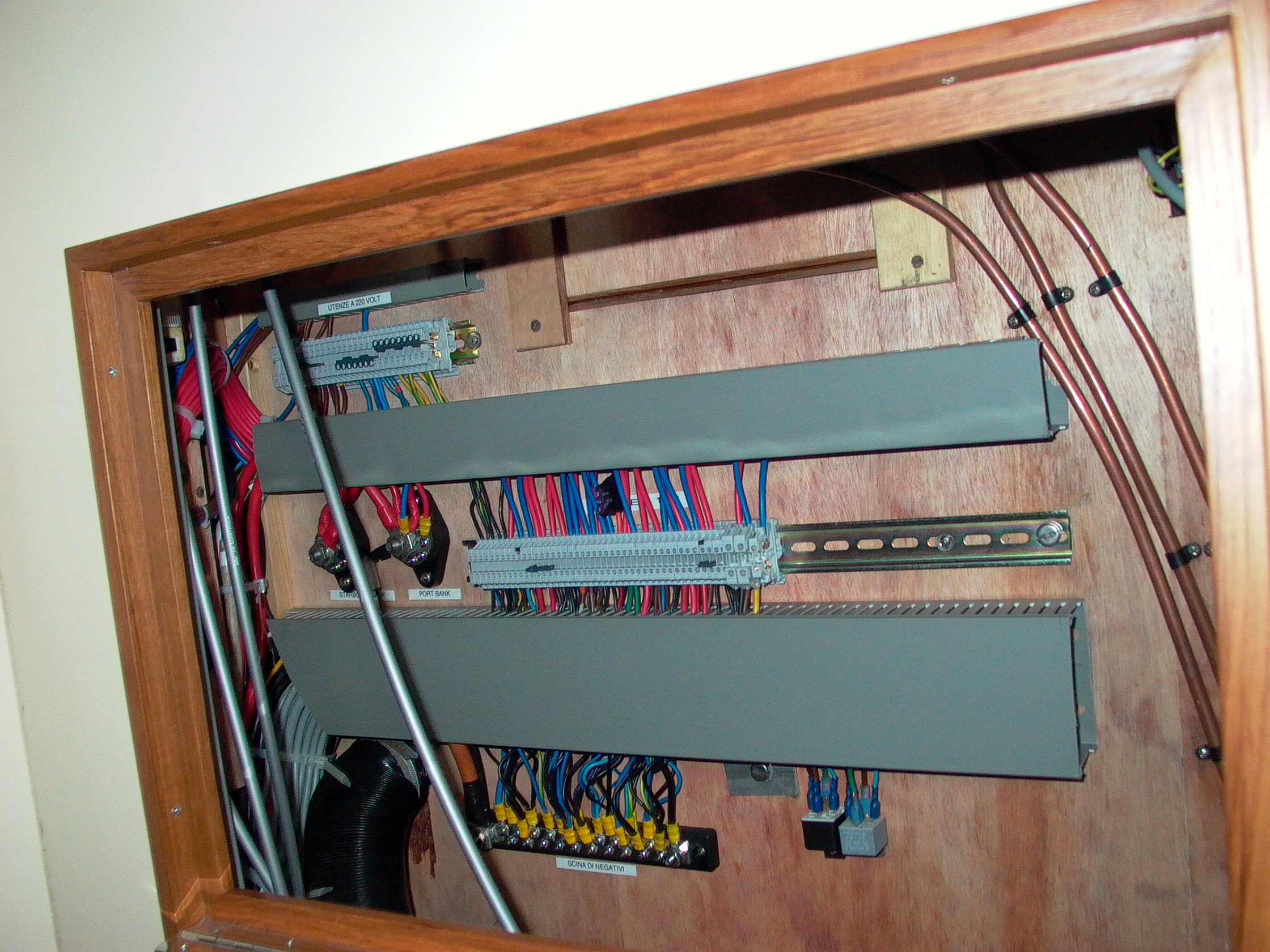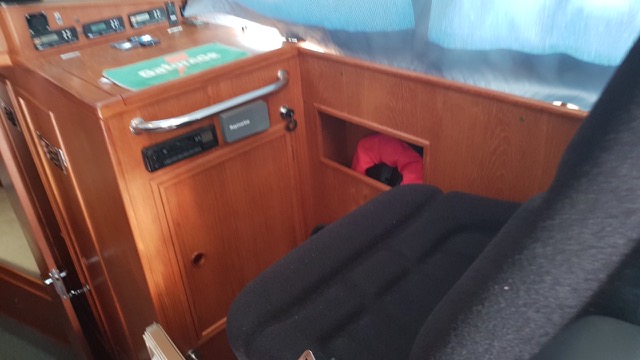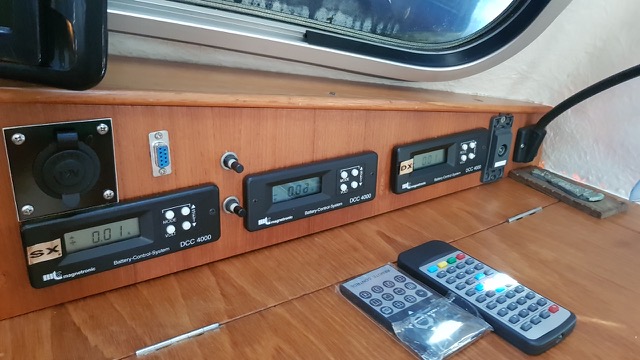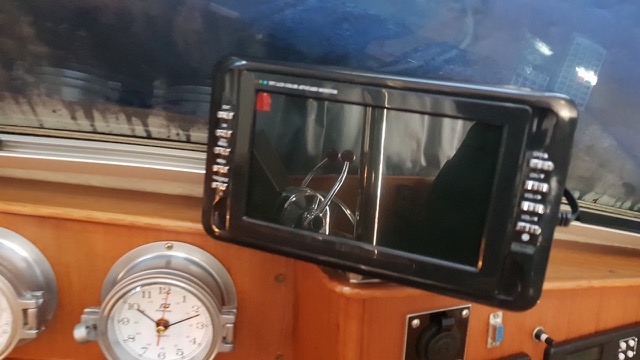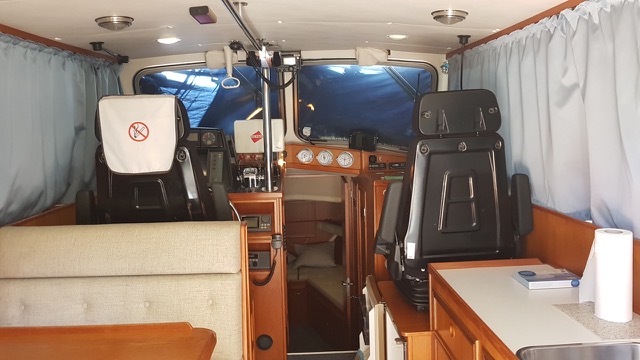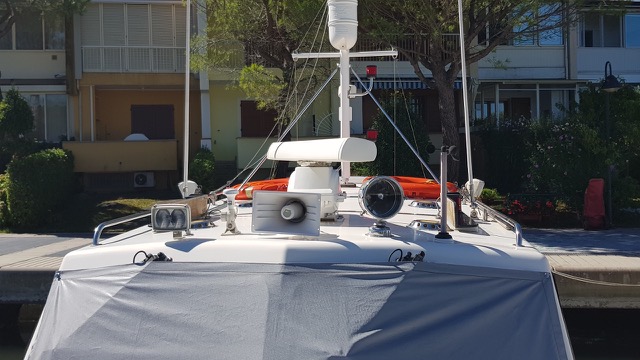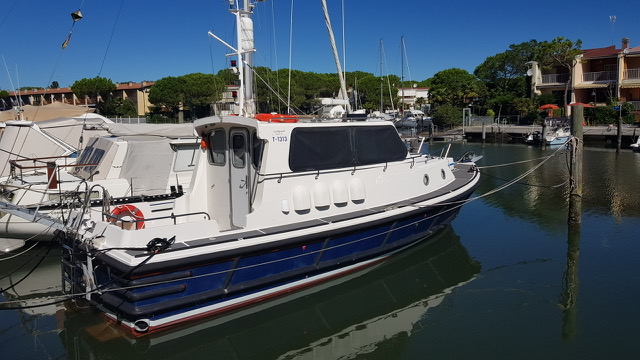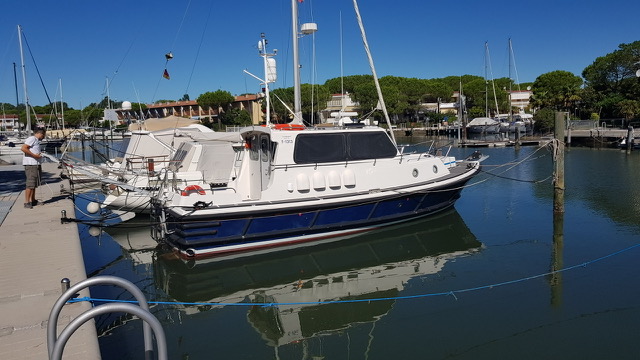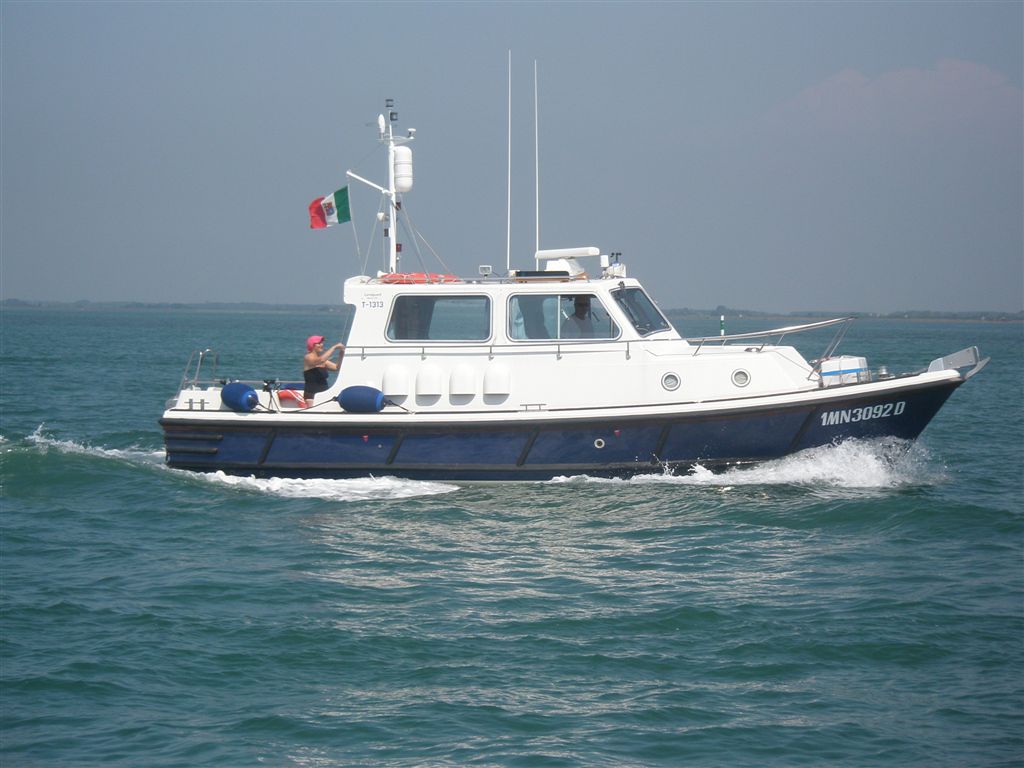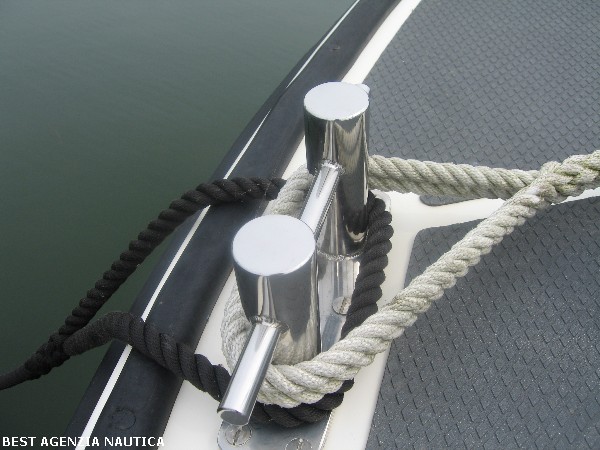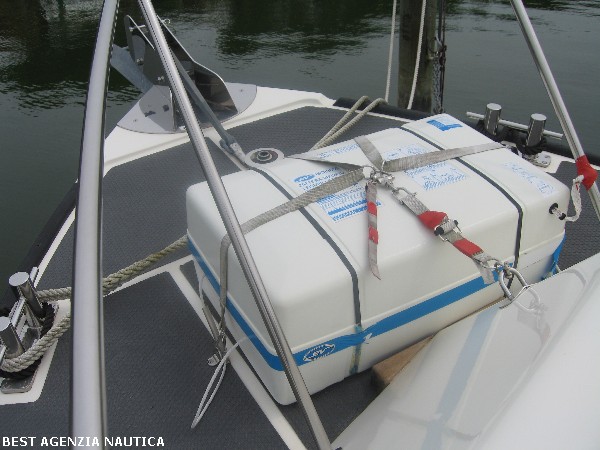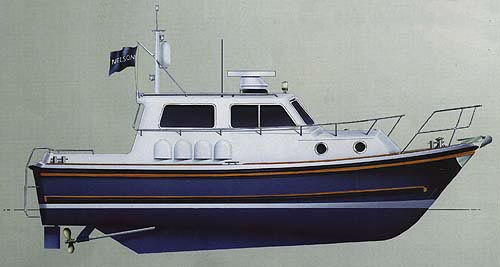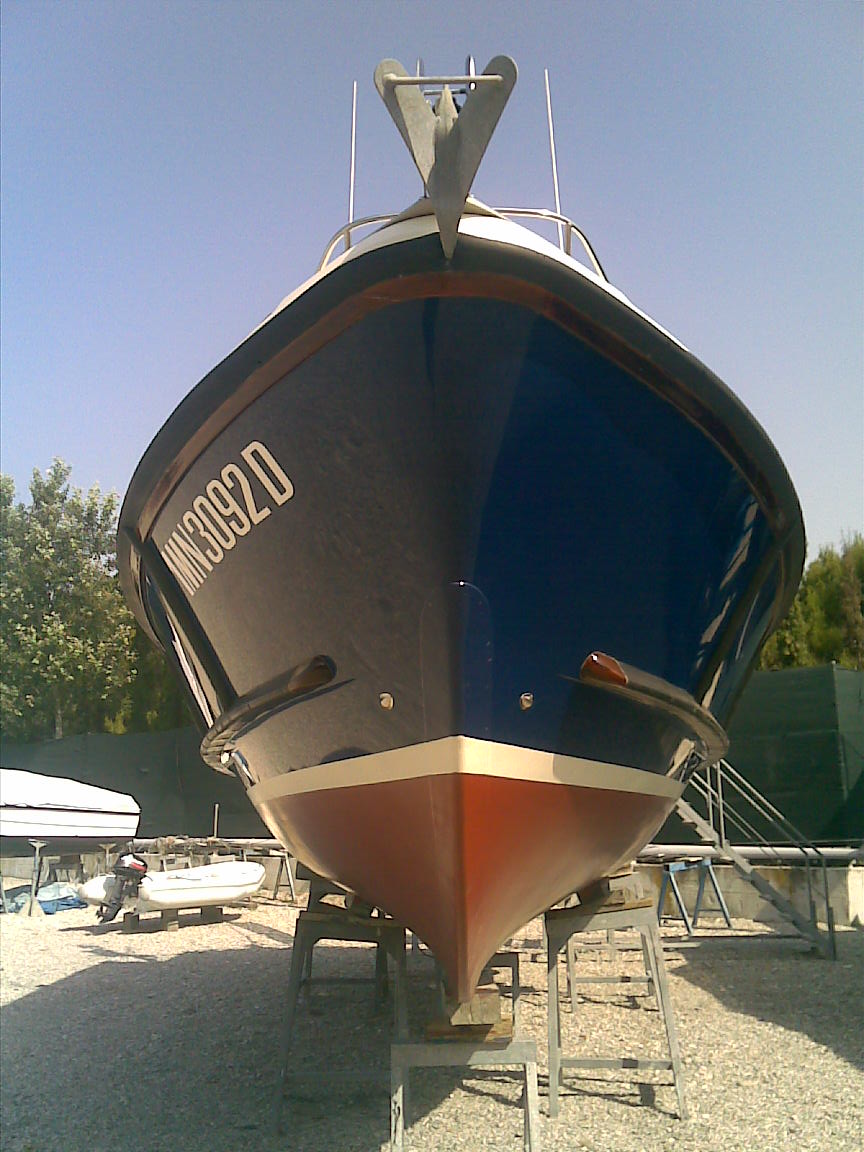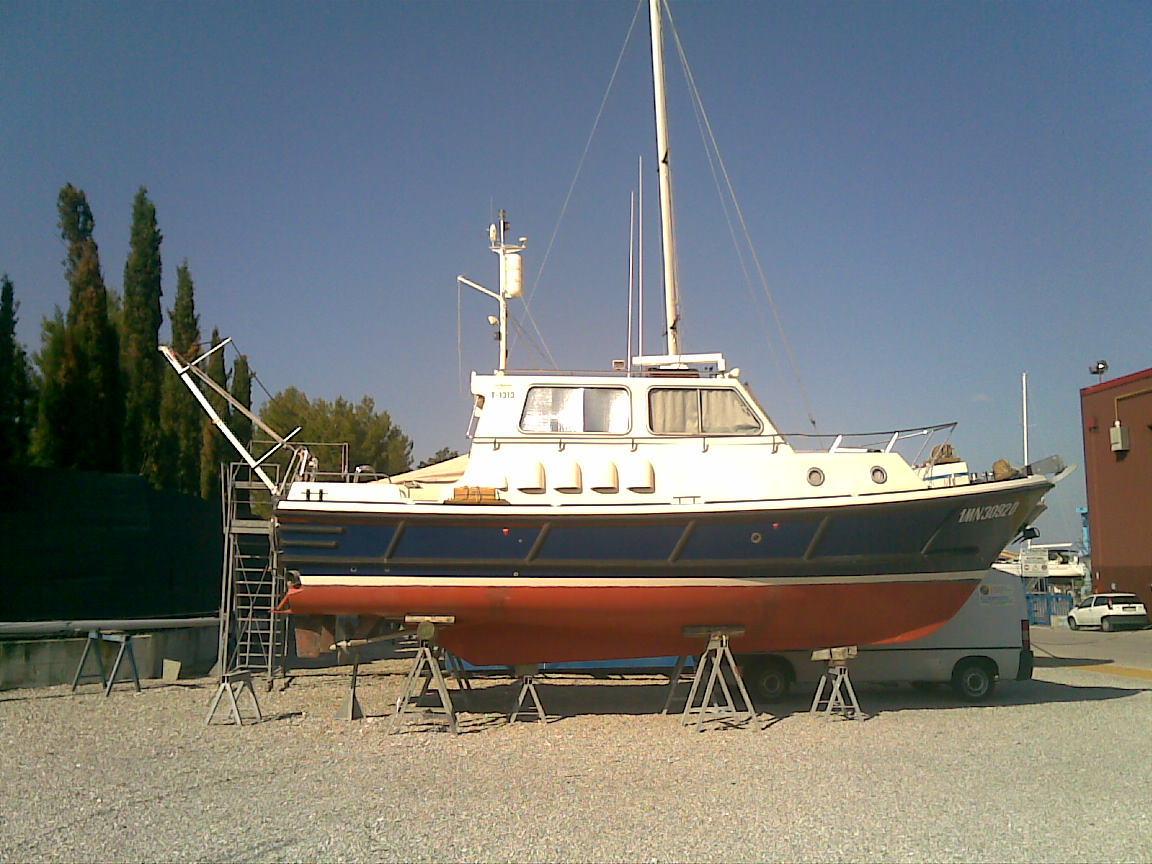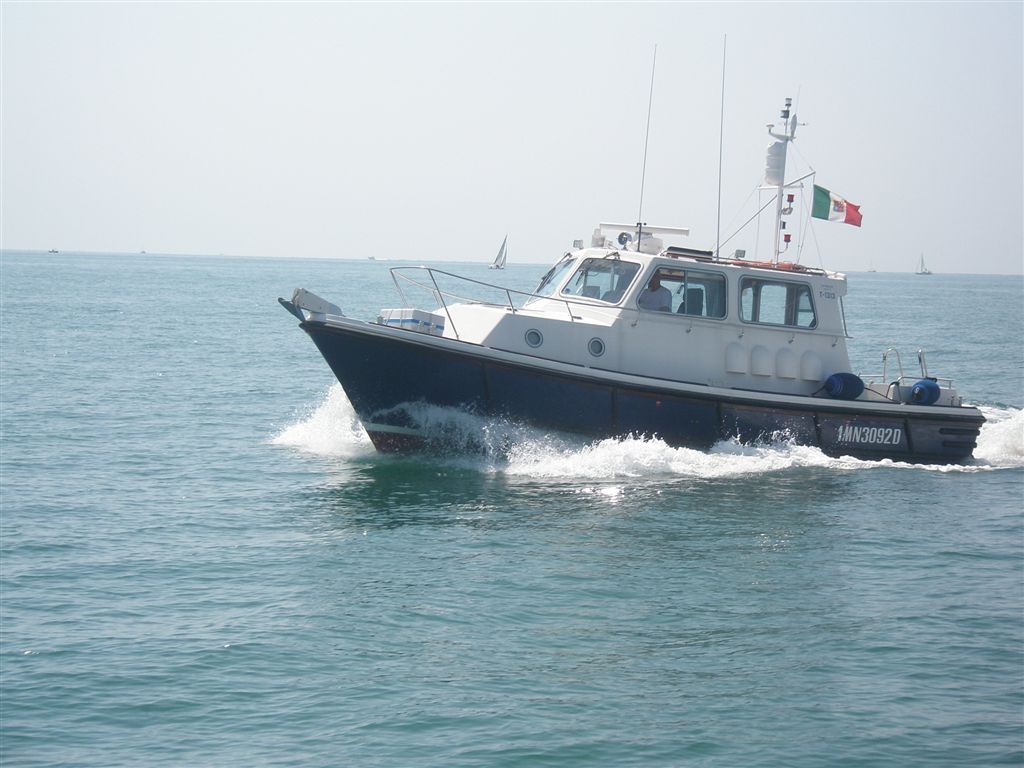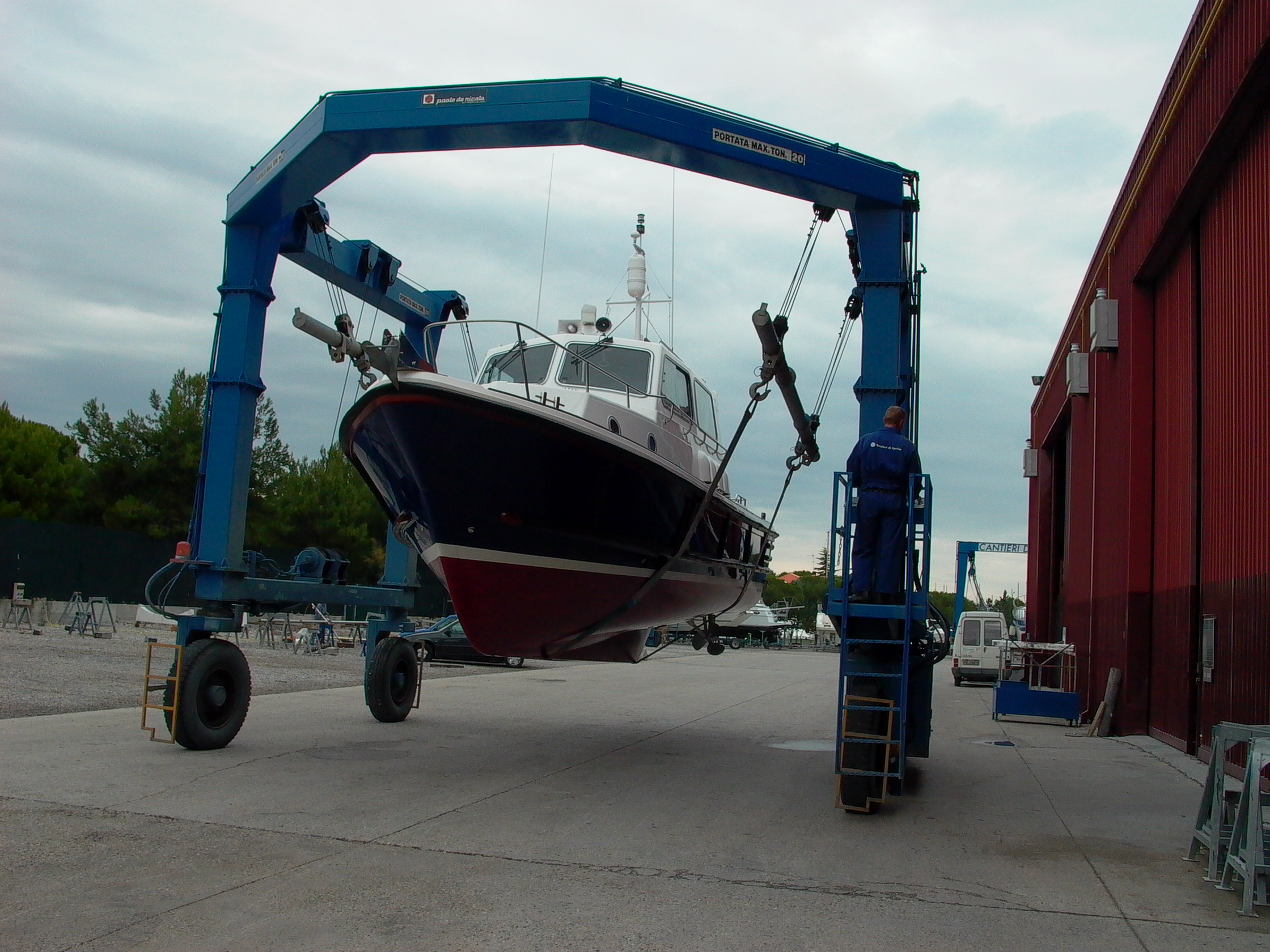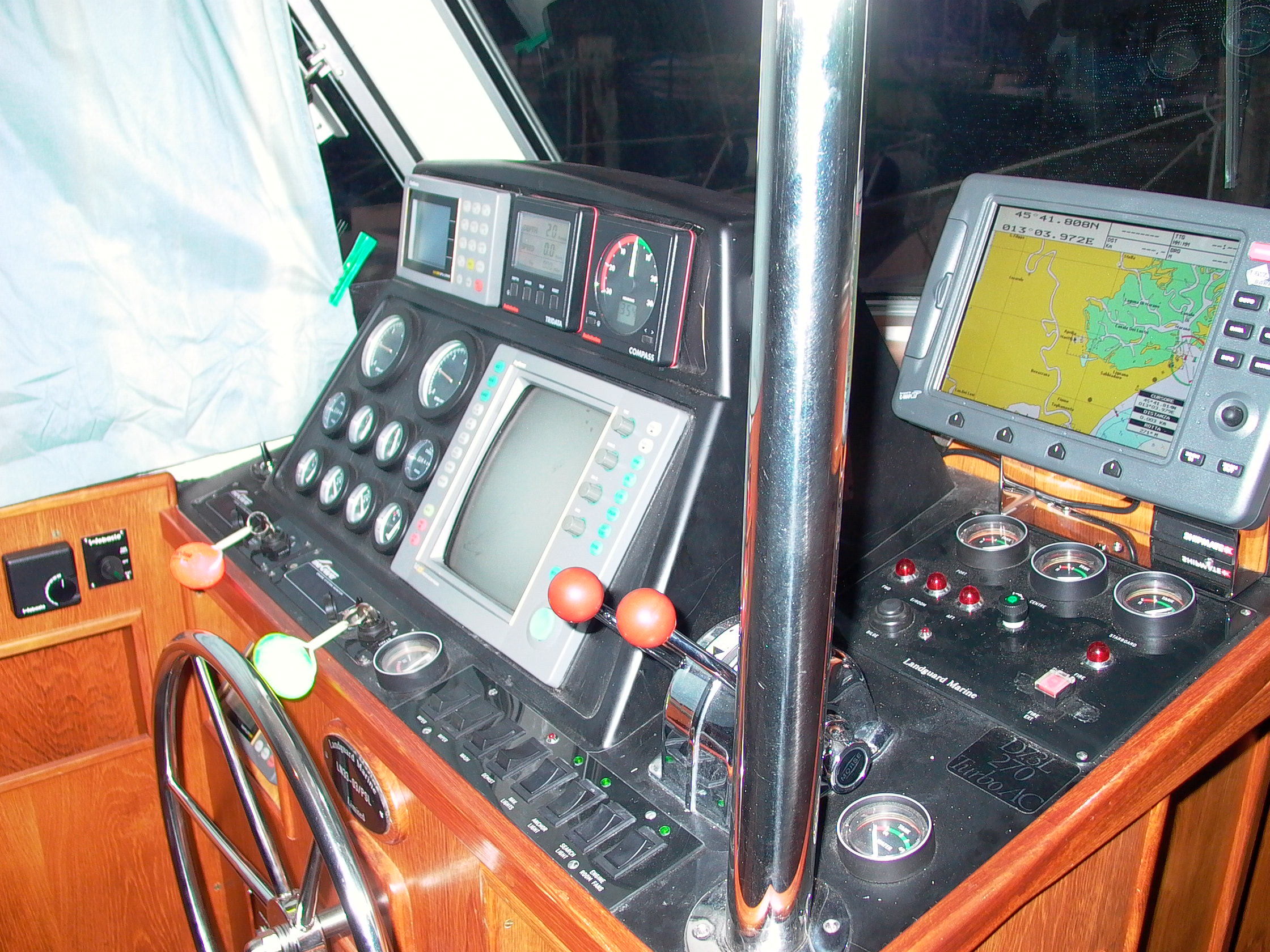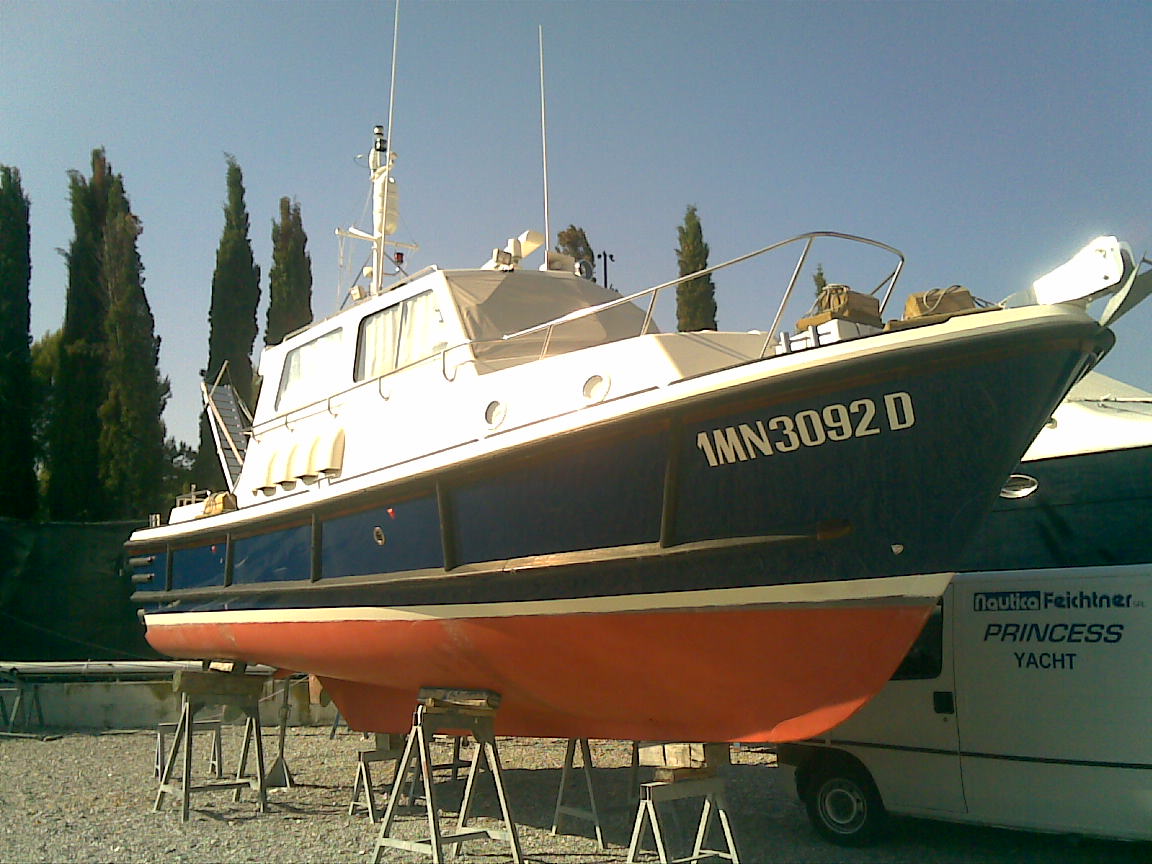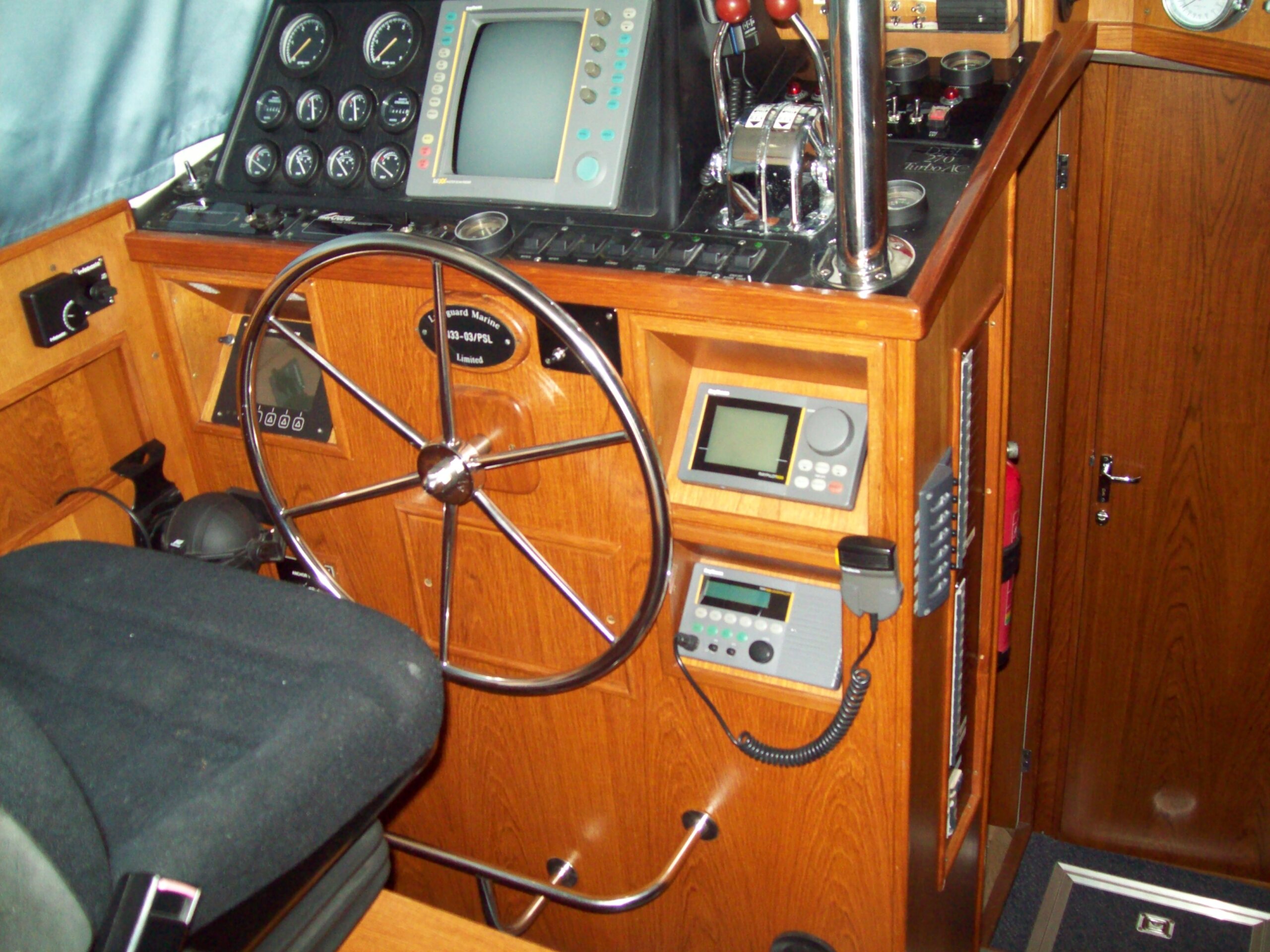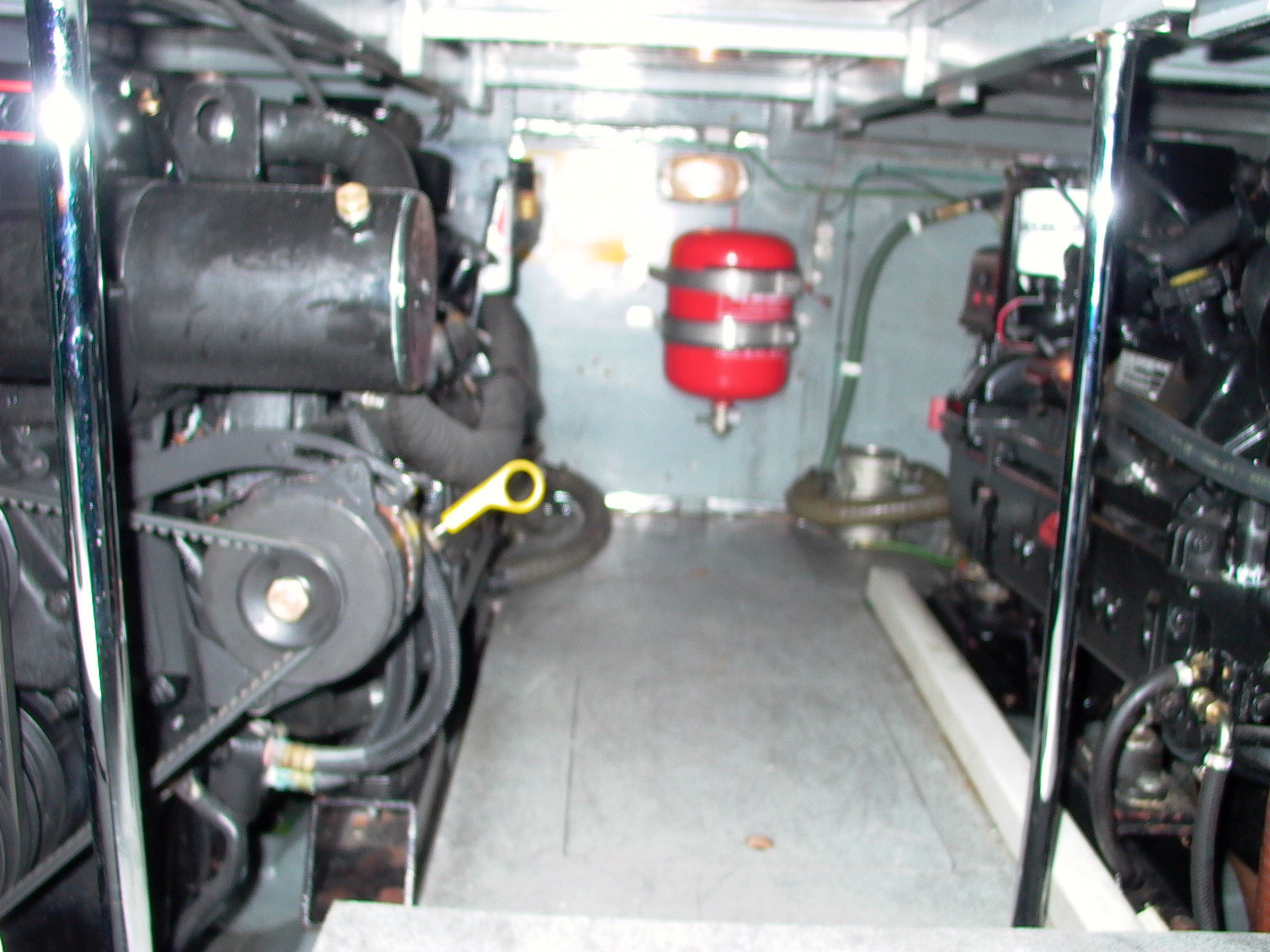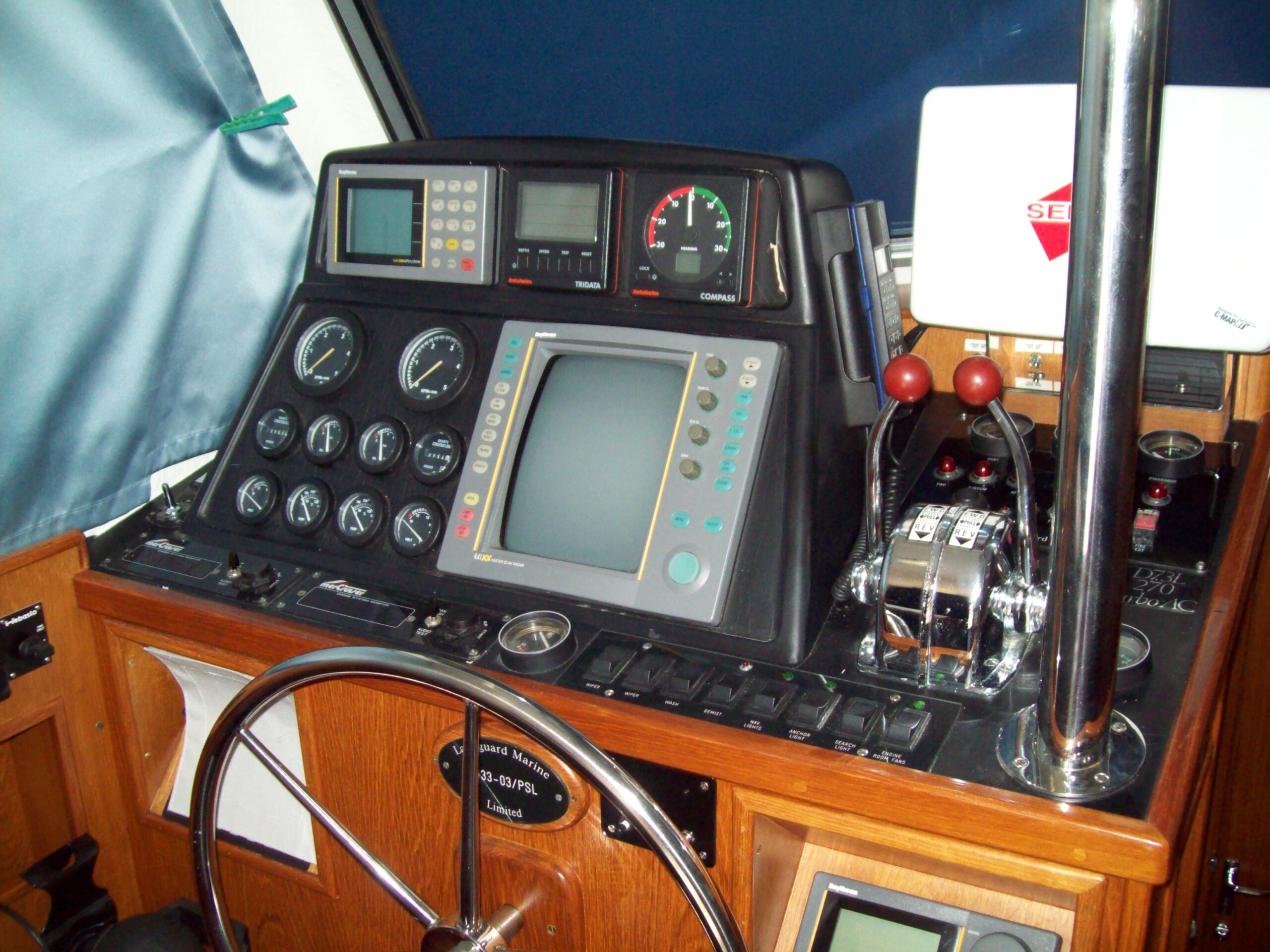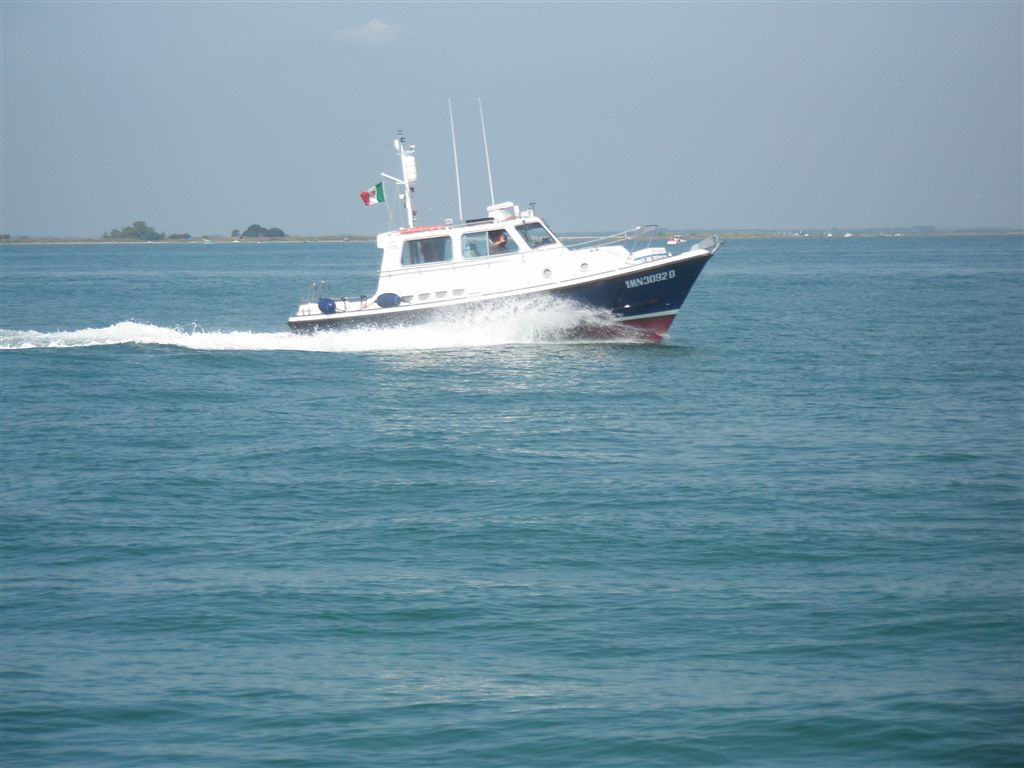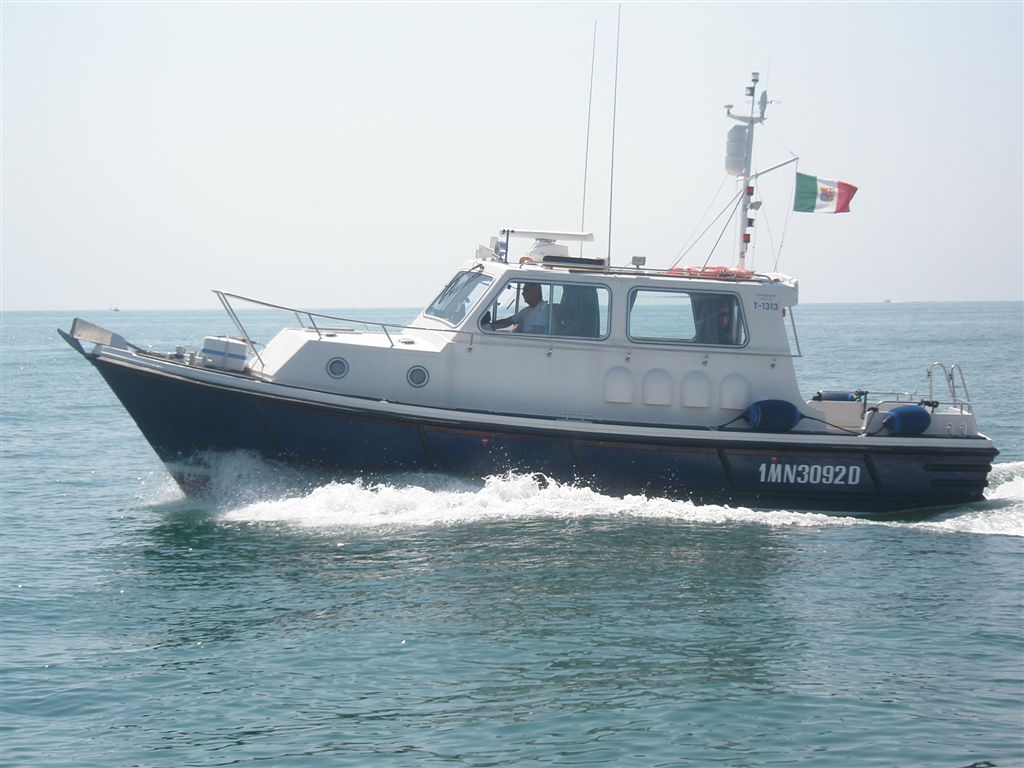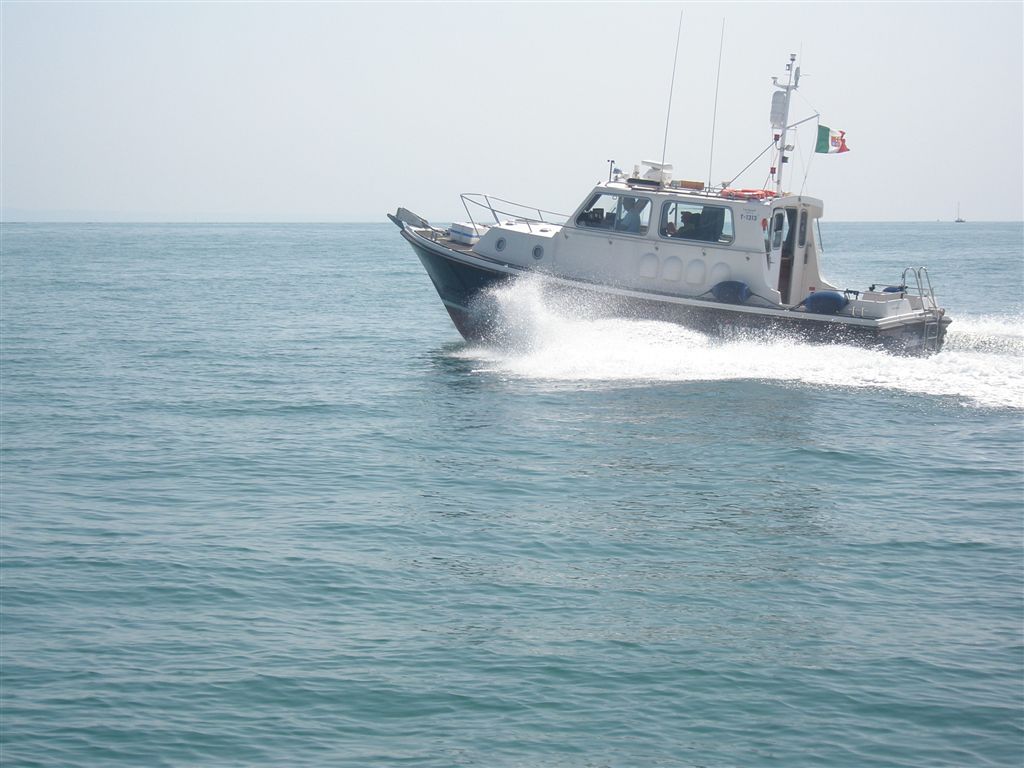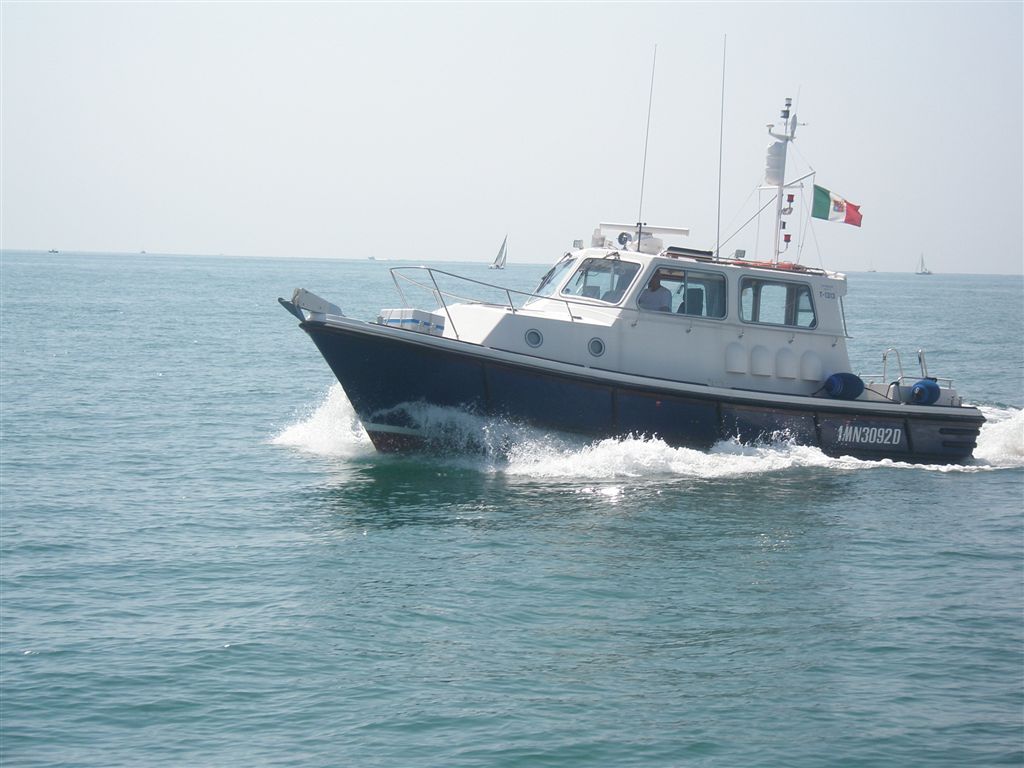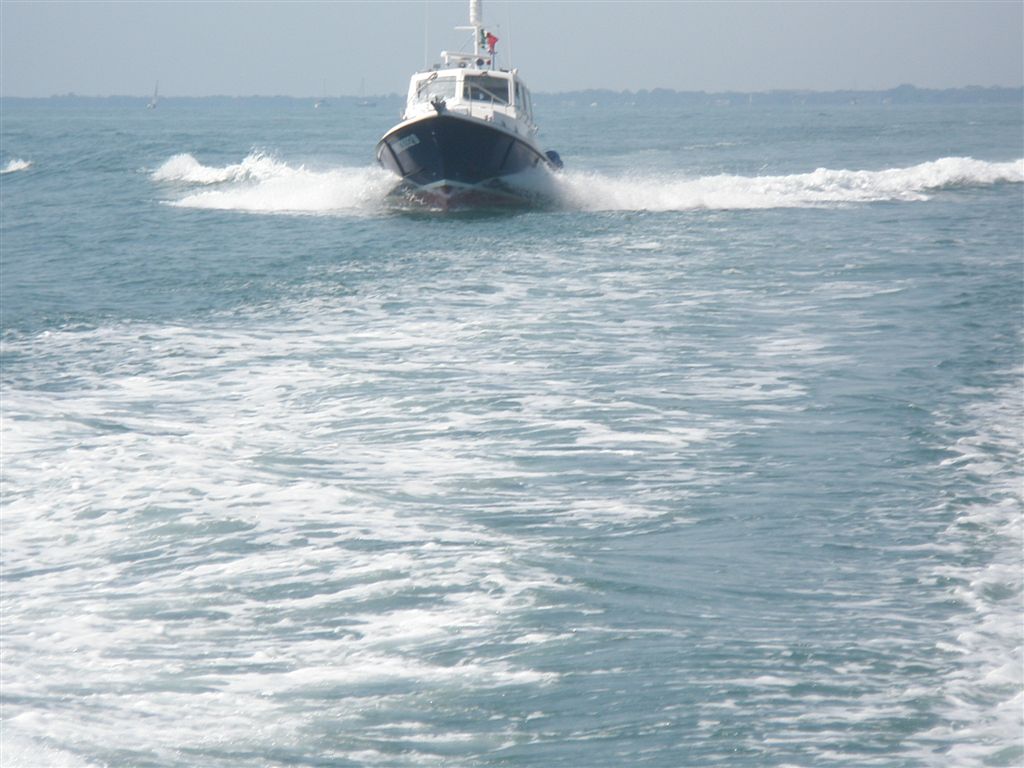Description & Specifications
Webasto Heatingsystem 7,6 kw,Eco Autohelm ST 50 TRIDATA,Autopilot Raypilot 650,GPS Furuno DGPS-37,Radar Raytheon R 41xx,Plotter Seiwa baramundi plus,UKW Shipmate RS 8300,E.P.I.R.B McMurdo Simrad EG 50 MAN,Fishfinder Techmarine.
LANDGUARD 33
Motor Boat and Yachting November 1994
She may look more at home butting out of the harbour mouth to drop a pilot aboard a visiting cargo ship, but she is a serious leisure boat.
The 33 is Landguard Marine’s second Nelson following the 28 launched in 1990. The new boat has impeccable Nelson credentials coming from the drawingboard of Arthur Mursell of TT Boat Designs, who continues to refine and develop those principles first seen in the original Nelson 40 and made familiar by hundreds of pilot boats, Customs’ cutters and harbourmasters’ launches.
In keeping with Nelson tradition, the 33’s hull is aimed primarily at the commercial market. Four superstructures are available: a fast angler, a general-purpose service launch, a patrol/service launch (PSL), and a motor yacht – this last with distinctive pilot-boat styling.
Varying levels of trim and interior appointments are available across the range, as evident on the subject of this test – the company’s PSL demonstrator,
fitted out inside to “private owner” specification. Externally, she looks very ‘official,’ with heavy D-section rubber gunwales and topside fendering, but minus the traditional teak badge-boards on the quarters.
Design and Construction
Essentially, early nelsons made their reputation as pilot boats through their ability to go hammering out of harbour in conditions that most other small craft couldn’t look at.
The basic ingredients were a very fine forefoot, a tight turn to the bilge to give a flat run aft and –most importantly-
narrow beam. The idea was to cut through the waves rather than ride over them; a Nelson in full flight was frequently hidden in sheets of spray.
Since then, the pressure has been on – particularly in the leisure market – to provide more hull volume while conserving its outstanding seakeeping abilities. The answer has been careful design development, close control over weight distribution and a degree of compromise. The Landguard is therefore a typical modern Nelson, retaining the basic characteristics of the earlier boats, carefully blended into a wider hull with more flare in the topsides.
Conventional construction techniques are used throughout. Chopped-strand mat and woven rovings are hand-laid in orthophthalic resin with foam-cored stringers and frames. As is common practice with this type of craft, the hull laminate is solid GRP and the scantlings are to commercial standards. End-grain balsa is used as a core material in the superstructure.
Accommodation
On the PSL version, the internal layout is dominated by the long wheelhouse, with sleeping accommodation under the relatively short coachroof.
The saloon sole is higher than one might expect, being just a few inches below deck level, so a commanding view is provided by the big windows. The seating layout is sheer simplicity, with the starboard side given over to a long, straight bench seat that has top-loading lockers underneath. To port, there’s a four-seater dinette immediately behind the helm seat, again with top-loading lockers in the seat bases.
The 2ft 10in x 3ft 0in (0.86m x 0.91m) table drops on to ledges in these bases to form a rather short double berth 5ft 10in long by 3ft 0in wide (2.08m x 0.91m). The lack of length seemed to be one of those ‘prototype’ problems, as there was at least 4in of wasted space between the dinette and the helm.
Headroom is good at 6ft 3in (1.91m) and the useful overhead handrail is sensibly offset to one side. Stowage for small items is provided by a fiddled shelf below the side windows and shelves in the locker below the navigator’s and helmsman’s seats. Wet oilies can be stowed in a well positioned hanging locker just inside the main door.
The finish on this private-owner version was pretty basic, with plain vinyl for the seating and satin-finish varnish for the teak woodwork. A certain amount of exposed GRP was visible around the windows, but I didn’t find it conspicuous.
Three steps lead down from the wheelhouse to the forward area, which has two rather narrow 6ft 6in x 2ft 1in (1.98m x 0.63m) vee-berths in the bows, the galley to starboard, and the heads compartment to port. Culinary arrangements on this boat included an Origo two-burner alcohol stove, a crockery rack in the aft bulkhead and reasonable stowage.
It seems rather odd to have the galley arranged open plan with the sleeping quarters, and I think many owners will want to move it upstairs in place of the long bench seat – especially as the fridge is located under the helm seat, anyway. This would have the further advantage of making room for a hanging locker and improved stowage in the cabin.
The heads compartment was fitted with a PAR manual toilet and a small basin with pressurised hot and cold water. A shower is an optional extra. Headroom is 6ft 0in (1.83m) and a couple of inches more in the cabin proper.
Again, the finish is far from luxurious. The hull lining is veneered plywood and the structural frames are visible between the panels. The bare white GRP is far more conspicuous because of the small portlights.
On Deck
From the average marina pontoon, you simply step aboard the 33 wherever you wish, thanks to the low freeboard and a complete absence of guardrails. Landguard have been brave enough to stick with commercial practice and extend the grabrail running below the wheelhouse windows around the outer edge of the coachroof on short, rigid stanchions, giving a continuous handhold from cockpit to pulpit at just the right height. And there’s another rail along the top of the wheelhouse, which allows you to toss boathooks and fenders up there as a temporary measure without them falling on your head. The sidedecks are covered in panels of grey, grippy Treadmaster with a substantial, half-round rubber toe-rail as a backup.
Moving along the sidedecks is unnerving at first, as there is nothing between you and the water, but after a few minutes it becomes second nature to lean inwards and hold on, and the job of carrying fenders back to the cockpit ceases to be a struggle down a narrow passageway. It’s the difference between apparent and actual safety.
The Landguard’s cockpit is a deep, secure well, 7ft 0in wide by 7ft 6in long (2.13m x 2.29m), with the coamings coming to just below shoulder height. In the very unlikely event of a sea coming aboard, enormous freeing ports would send it back in short order. Instead of the usual arrangement of drain channels, a watertight cast-alloy hatch in the cockpit sole
secures the lazarette -–which, although rather shallow, has room for a liferaft, inflatable and outboard.
At the cockpit’s front end a raised section acts as a step up to saloon level, and side extensions double as seats and steps to the sidedecks. Top-loading lockers below them have heavily moulded, rear-hinged tops, which shut with a resounding clunk. Removable GRP liners lift out for convenience and give access to the exhaust runs.
Cushions are conspicuous by their absence; the seats and sole are Treadmaster covered, in keeping with the boat’s functional ethic.
Engines
As with many workboats, the 33 is available in single or twin-engine form. A pair of 150hp (112kW), four-cylinder turbocharged Cummins B series are regarded as the standard twin-engine fit, but being a demonstrator, our test boat had the optional six-cylinder, turbocharged and after-cooled versions, giving no less than twice that power.
Thanks to down-angle MPM gearboxes, the engines are mounted level, giving good clearance below the saloon sole. A rather small hatch opens on to a surprisingly spacious engineroom with a convenient, level floor between the power units. This extends across the front of the engines to provide a neat mounting for the calorifier, batteries and ancillary equipment. An encapsulated genset could be accommodated with ease.
The primary fuel filters, seacocks and routine engine-maintenance points are all easy to reach, but the remote raw-water strainers were a bit far outboard for comfort: a problem simply rectified.
The engines draw their fuel from a central 120gal (545 litre) collector tank below the engineroom sole, which is fed from two 100gal (455-litre) wing tanks in the lazarette. Fuel returning from the injection pumps is always fed to the wing tanks to keep the fuel in the collector as cool as possible. As fuel is burned off, there is therefore a transfer of weight forward, which is intended to be beneficial to performance.
I was impressed with the heavy-duty, commercial-standard engineering specification throughout the boat, and the thought that had gone into long-term safety and reliability. For example, the bilge is divided into three watertight compartments, each with its own high-level alarm. The 1½” Jabsco pump on the port engine (and the standby manual pump) can be selected through a changeover manifold to the relevant compartment. The manual pump is carefully positioned in the cockpit where you can really put some effort into its operation. Again, it is a matter of moments to fit the emergency tiller on to the square end of one of the specially extended rudder stocks in the aft locker, and one could then sit in the cockpit and steer in reasonable comfort.
The main fire-prevention system consists of a 72oC heat sensor wired to a prominent audio/visual alarm, while the 4kg Halon extinguisher has a fusible link set to operate automatically at 93oC. Engineroom air-vent flaps are available as an option. Two 250Ah battery banks are split between domestic and operational supplies with heavy-duty circuit breakers in place of the more normal master switches.
Handling and Performance
To properly test a Nelson, one really needs upwards of Force 5, but on the day of our test a Force-4 with occasional white horses over an underlying swell gave a fair indication of the boat’s potential. Certainly she was much dryer than might have been expected – spray being cleared in a nice flat pattern well aft of the windscreen. Upwind, the effects of the increased beam could be felt as a gentle check on progress as the bow rose gently to the seas rather than simply slicing through them. The motion, however, was soft, nicely damped, and perfectly comfortable.
With 600hp (448kW) under the sole, performance was understandably brisk, the five to 20-knot increment taking just 15 seconds. We recorded a mean maximum of 27.5 knots: an excellent turn of speed for a supposedly semi-displacement boat of this size. Even so, she could be whipped round in little more than two boat lengths with complete confidence. Full speed in quartering seas revealed some tenderness that was simply quelled by throttling back a bit. Noise and vibration levels remained surprisingly low.
All this power exacts a toll when it comes to low-speed handling. Engaging gear results in immediate – one might say, abrupt – forward movement requiring a delicate touch on the controls and careful anticipation. Things weren’t helped on the day of the test by slightly high idle settings on both engines, giving a ‘slow head’ of nearly six knots.
In the wheelhouse, Landguard’s demonstrator is fitted with expensive, professional shock-absorbing seats for helmsman and navigator, but conventional benches are the norm for leisure use. The instrument console is a large, flat black panel with the dials and switches arranged in a workmanlike manner: burr walnut would be out of place here. The
vertical wheel and single-lever Morse controls are similarly in keeping.
Across from the helm position, the navigation station offers a 20in-square pilotage chart table with a useful 7in-deep locker under the lod. Serious planning would need to be done on the saloon table. One complaint: on this boat, the radar was suspended from the deckhead directly above the companionway – guaranteed to give you a crack on the head as you emerged from the galley.
Conclusion
TT Boat Designs have responded to Landguard’s brief with a design of modern proportions while preserving, and in
some cases improving on traditional Nelson virtues, and the builders have followed through with engineering to suit. Their suggested fit-out for private-owner use seems a little sparse, but that can easily be changed to suit individual preferences.
Undoubtedly a Nelson through and through, the new Landguard is a worthy addition to the much respected line.
Key facts at a glance
| Construction year | 1995 |
|---|---|
| Material | GFK |
| Engine | 2 x Mercruiser V 8 Turbodiesel 7,3L/270 (270 PS) |
| Output | 1000 h |
| Transmission | Shaft |
| Cruising speed | 20 kn |
| Max. speed | 24 kn |
| Fuel tank | Diesel (1250 l) |
| Fresh water tank | 270 l |
| Berth | Aprilia Marittima (UD) |
| Length | 10,08 m (33,07 ft) |
|---|---|
| Width | 3,50 m (11,48 ft) |
| Draft | 1,30 m (4,27 ft) |
| Weight | 9500 kg |
| Cabins | 1 |
| Beds | 4 |
| Bathrooms | 1 |
| Condition | Very Good |
Disclaimer
The Company provides the information about this vessel / boat in good faith, but can not guarantee or warrant the accuracy of this information and the condition of the vessel / boat. Buyers should mandate agents or reviewers to review the features whose validation is important to them. The offer of this vessel / boat is subject to prior sale, price change or withdrawal of the offer without prior notice.


